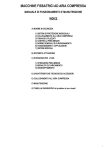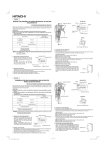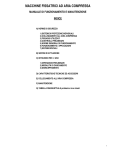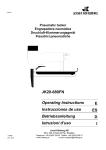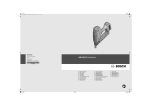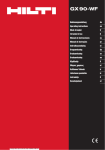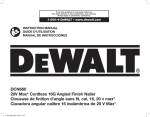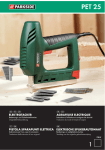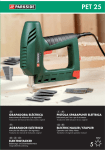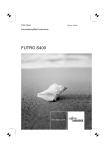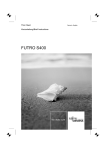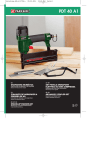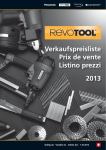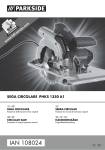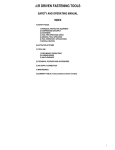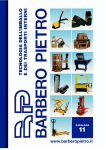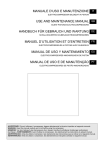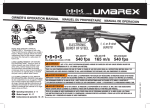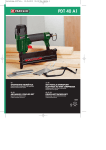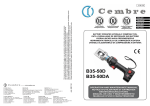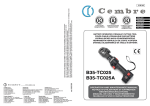Download 184355, 184356, 184354, 184358 de
Transcript
Artikel-Nr. / Article No.: 184355, 184356, 184354, 184358 Sprachen / Languages: de BERNER_81408.pdf 2013-12-26 PNEUMATISCHE HEFT- UND NAGELMASCHINEN BETRIEBS- UND WARTUNGSANLEITUNG INHALTSVERZEICHNIS A) SICHERHEITSVORSCHRIFTEN 1) 2) 3) 4) 5) 6) 7) KÖRPERSCHUTZMITTEL DRUCKLUFTANSCHLUSS BEFESTIGUNGSMITTEL VORBEREITENDE KONTROLLEN ALLGEMEINE GEBRAUCHSVORSCHRIFTEN FUNKTIONSWEISE / ANWENDUNGEN SONDERSYSTEME B) AUSLÖSESYSTEME C) GEBRAUCHSANWEISUNGEN 1) VORBEREITENDE ARBEITEN 2) LADEN DER MASCHINE 3) BEHEBEN VON KLEMMUNGEN D) TECHNISCHE MERKMALE UND ZUBEHÖR E) DRUCKLUFTANSCHLUSS F) WARTUNG G) ÜBERSICHTSTABELLE: Fehlfunktionen und Abhilfe Der Hersteller erklärt, dass dieses Gerät in Übereinstimmung mit den europäischen Richtlinien EN 792-13:2000 +A1:2008, 2006/42/EC und EN ISO 12100-1/2, sowie der Amerikanischen Norm ANSI SNT-101-2002 entworfen wurde. A) SICHERHEITSVORSCHRIFTEN Vor dem Laden, der Handhabung, dem Gebrauch, der Einstellung oder der Reparatur der Heft- und Nagelmaschine müssen sich alle Benutzer und ihre Vorgesetzten die Sicherheitsvorschriften und die Sicherheitszeichen gut aneignen. Stets alle für einen sicheren Gebrauch erforderlichen Vorsichtsmaßnahmen treffen und sicherstellen, dass alle Personen, die sich im Arbeitsbereich aufhalten, angemessene Körperschutzmittel tragen. Die Maschine nicht in Betrieb nehmen, wenn diese Anweisungen nicht umgesetzt wurden. Die Heft- und Nagelmaschine nicht verwenden, wenn der Aufkleber mit Sicherheitssymbolen fehlt. In diesem Fall ziehen Sie den Hersteller, den nächsten Händler (Anschrift auf der Rückseite dieses Handbuchs) oder den Kundendienst zu Rate. 1) KÖRPERSCHUTZMITTEL ALLE FÜR DIE LAUFENDE ANWENDUNG ERFORDERLICHEN KÖRPERSCHUTZMITTEL TRAGEN. Die Missachtung dieser Vorschrift kann zu einer schwerwiegenden Gefährdung des Benutzers und der Personen führen, die sich in der Nähe aufhalten. 1.1) SCHUTZBRILLE TRAGEN: während des Gebrauchs und der Wartung der Maschine sowie bei Aufenthalt im Arbeitsbereich der Maschine stets Schutzbrillen mit Front- und Seitenschutz tragen, die von den zuständigen Stellen (ISO, EN) zugelassen sind. Die Missachtung dieser Vorschrift kann zu einer ernsthaften Gefährdung durch weggeschleuderte Befestigungsmittel und Splitter führen. 1.2) GEHÖRSCHUTZ TRAGEN: bei der Arbeit in der Nähe der Maschine. Ist man wiederholt einer kontinuierlichen Lärmbelastung ausgesetzt, kann dies zu Schwerhörigkeit oder zumindest zu einer Beeinträchtigung des Gehörsinns führen. 1.3) SCHUTZHELM TRAGEN: bei besonderen Anwendungen, bei denen über Kopf gearbeitet werden muss. Auch bei der Arbeit auf Gerüsten, Arbeitsbühnen, Leitern oder Decken, von denen Gegenstände herabfallen könnten, einen Schutzhelm tragen. Wenn der Benutzer oder die sich in der Nähe aufhaltenden Personen keinen angemessenen Kopfschutz tragen, kann dies nicht nur zu einer Gefährdung durch herabfallende Gegenstände und Arbeitsmaterialien, sondern auch durch den direkten Kontakt mit der Heft- und Nagelmaschine selbst führen. 2) DRUCKLUFTANSCHLUSS 2.1) KEINESFALLS UNTER DRUCK STEHENDE ODER BRENNBARE GASE VERWENDEN. Ausschließlich saubere und trockene Luft zur Speisung verwenden. Der Gebrauch einer anderen Energiequelle als Druckluft kann zu Explosionen und den entsprechenden Gefahren für die Gesundheit der gefährdeten Personen führen. Das Gerät darf nicht an eine Luftversorgung, die 200 psig oder 13,7 bar überschreitet, angeschlossen werden. 2.2) NIEMALS DEN EMPFOHLENEN HÖCHSTDRUCK ÜBERSCHREITEN. Kontrollieren, ob der Druckanzeiger einwandfrei funktioniert, und sich häufig vergewissern, dass der zulässige Höchstdruck nicht überschritten wird. Bei Betrieb der Maschine mit zu hohem Druck kann die Eindringtiefe zu groß sein bzw. das Befestigungsmittel durch das Werkstück dringen; außerdem führt dies zu einem vorzeitigen Verschleiß der Komponenten und infolgedessen zu Verletzungsgefahr durch weggeschleuderte Befestigungsmittel und Werkstückbruchstücke. 2.3) Sicherstellen, dass der MINDESTDRUCK zum Eintreiben des Befestigungsmittels ausreicht. Senkt man den Druck unter den erforderlichen Mindestdruck, kann dies zu einer Verstärkung des Rückschlags der Maschine führen. 2.4) STETS EINEN SCHNELLVERSCHLUSS MIT AUSSENGEWINDE VERWENDEN, damit die Restenergie nach dem Abstecken der Druckluftleitung aus der Maschine entweichen kann. Niemals Anschlüsse mit Innengewinde oder sonstige Anschlüsse verwenden, die das Austreten der Druckluft nach dem Abstecken der Druckluftleitung von der Maschine verhindern. Wenn in der Heft- und Nagelmaschine Luft bleibt, kann sie auch nach dem Abstecken der Speiseleitung einen Schuss auslösen und so zu einer ernsthaften Gefährdung des Benutzers und der Personen, die sich in der Nähe aufhalten, führen. 2.5) ANSCHLÜSSE VERWENDEN, die für 150 psig (10,3 bar) ausgelegt sind oder 150% des zulässigen Höchstdrucks völlig sicher aushalten können. Die normalen Belastungen können Verschleiß und somit ein Nachgeben der Anschlüsse verursachen, wodurch es zu vorzeitigem Bruch und plötzlichen Druckverlusten und folglich zu einer Verstärkung des Rückschlags kommen kann. 3) BEFESTIGUNGSMITTEL 3.1) AUSSCHLIESSLICH BEFESTIGUNGSMITTEL VERWENDEN, deren Typ, Abmessungen und Toleranzen den ANGABEN FÜR DIE MASCHINE entsprechen. Die Verwendung von ungeeigneten Befestigungsmitteln kann zu Klemmungen, Bruch des Befestigungskopfs und/oder Verlust der Führung während des Schusses und folglich zur Gefahr einer mangelnden Kontrolle der Schussrichtung führen. Beim Kundendienst die Anschrift des nächsten Befestigungsmittelhändlers erfragen. 3.2) DIE MASCHINE STETS KONTROLLIEREN, um sie mit den Befestigungsmitteln geeigneter Länge zu laden. Die Verwendung einer falschen Länge kann zu einer Verstärkung des Rückschlags, zu einem übermäßigen Eindringen, zum Bruch des Werkstücks und zum Durchdringen des Werkstücks und folglich zu einer Gefährdung des Benutzers oder von Personen, die sich in der Nähe aufhalten, führen. 4 VORBEREITENDE KONTROLLEN 4.1) DIE HEFT- UND NAGELMASCHINE VOR GEBRAUCH KONTROLLIEREN und sicherstellen, dass die Befestigungsschrauben fest angezogen sind. Druckverluste können zu einer Leistungsminderung und zur Verstärkung des Rückschlags führen. 4.2) DIE FUNKTIONSFÄHIGKEIT DES ABZUGSHEBELS UND DER SICHERUNG SICHERSTELLEN um sicher sein zu können, dass die Maschine einwandfrei funktioniert: a) Immer annehmen, dass das Gerät Munition enthält. Das Gerät könnte ein Befestigungsmittel abfeuern, wenn es an die Luftversorgung angeschlossen wird. Deshalb vor dem Anschließen alle Befestigungsmittel aus dem Magazin entfernen. b) Am nicht angeschlossenen Gerät muss täglich die korrekte Funktion des Abzugshebels überprüft werden. Verwenden Sie das Gerät nicht, falls der Hebel klemmt. c) Die entladene Heft- und Nagelmaschine an die Druckluft anschließen und die Sicherung vollständig gegen das Werkstück drücken, ohne den Ventilhebel zu betätigen. Die Maschine darf in diesem Zustand nicht auslösen. d) Die Heft- und Nagelmaschine in eine Richtung halten, in der keine Gefahr besteht, und den Ventilhebel betätigen. Die Maschine darf nicht auslösen. e) Wenn die Heft- und Nagelmaschine während der vorgenannten Prüfungen auslösen sollte, die Druckluftleitung abstecken und den Kundendienst zu Rate ziehen. Die Heft- und Nagelmaschine nicht verwenden, wenn die Sicherung klemmt oder beschädigt ist. Die Heft- und Nagelmaschinen mit Auslösesicherung sind mit einem auf dem Kopf stehenden Dreieck () gekennzeichnet. Die Auslösesicherung erlaubt die Auslösung nur dann, wenn die Nase der Maschine gegen das Werkstück gedrückt wird. 5) ALLGEMEINE GEBRAUCHSVORSCHRIFTEN 5.1) DIE HEFT- UND NAGELMASCHINE NICHT MIT GEDRÜCKTEM VENTILHEBEL GREIFEN ODER TRANSPORTIEREN. Für den Transport der Heft- und Nagelmaschine stets die Druckluftleitung abstecken. Wenn der Ventilhebel betätigt ist, kann eine zufällige Berührung der Auslösesicherung unvorhergesehenerweise einen Schuss auslösen und folglich den Benutzer oder andere Personen gefährden. 5.2) DIE HEFT- UND NAGELMASCHINE NICHT AN DER DRUCKLUFTLEITUNG ZIEHEN, um die Leitung und die Anschlüsse nicht zu beschädigen. Für den Transport der Heft- und Nagelmaschine in einen anderen Arbeitsbereich die Druckluftleitung abstecken. 5.3) Nach der Auslösung DEN VENTILHEBEL VOLLSTÄNDIG LOSLASSEN und erst dann erneut betätigen, wenn die Heft- und Nagelmaschine wieder auf das Werkstück aufgesetzt wurde und bereit für die nächste Auslösung ist. Eine unvorhergesehene Auslösung kann für den Benutzer oder andere in der Nähe befindliche Personen äußerst gefährlich sein. 5.4) DIE HEFT- UND NAGELMASCHINE STETS IN EINE SICHERE RICHTUNG HALTEN, um eine Gefährdung von Personen zu verhindern. Niemals annehmen, dass das Gerät leer ist. Stets sicherstellen, dass sich in der Flugbahn des Befestigungsmittels, das u.U. das Werkstück durchschlagen und auf der anderen Seite austreten kann, keine Personen aufhalten. Ein frei umherfliegendes Befestigungsmittel kann bei den getroffenen Personen 6) FUNKTIONSWEISE / ANWENDUNGEN 6.1) NICHT AUF EINER WERKSTÜCKKANTE AUSLÖSEN. Das Befestigungsmittel kann abgleiten und unkontrolliert wegfliegen bzw. vom Werkstück zurückprallen und in der Nähe befindliche Personen treffen. 6.2) NICHT AUF ZU HARTEN WERKSTOFFEN ODER ANDEREN BEFESTIGUNGSMITTELN AUSLÖSEN. Die Heft- und Nagelmaschine und auch das Befestigungsmittel können zurückprallen und den Benutzer oder in der Nähe befindliche Personen verletzen. 6.3) DIE HEFT- UND NAGELMASCHINE NICHT IN DER NÄHE VON ENTFLAMMBAREN SUBSTANZEN ODER GASEN VERWENDEN. Ein von der Heft- und Nagelmaschine erzeugter Funke könnte einen Brand oder eine Explosion auslösen und so zu schwerwiegenden Verletzungen des Benutzers oder in der Nähe befindlicher Personen führen. 6.4) DIE HEFT- UND NAGELMASCHINE FEST UND SICHER GREIFEN, um sie auch bei einem plötzlichen Rückschlag unter Kontrolle zu haben. Die Heft- und Nagelmaschine leicht zurückprallen lassen und ihre Bewegungen kontrollieren, um zu verhindern, dass sie sich auf eine andere Befestigung oder ein Körperteil des Benutzers positioniert. 6.5) DIE GLIEDMASSEN UND ANDERE KÖRPERTEILE STETS VOM WERKSTÜCK FERNHALTEN. Ein Befestigungsmittel könnte zurückprallen bzw. das Werkstück durchschlagen und auf der anderen Seite austreten und so den Benutzer verletzen. 6.6) DIE HEFT- UND NAGELMASCHINE NICHT ALS HAMMER BENUTZEN. Es besteht die Gefahr, dass durch den Rückschlag auf die inneren Bauteile der Maschine ein Schuss ausgelöst wird, der zu einer Verletzung des Benutzers oder von in der Nähe befindlichen Personen führt. 6.7) DIE HEFT- UND NAGELMASCHINE KEINESFALLS VERÄNDERN. Ohne Genehmigung des Herstellers ausgeführte Veränderungen können zu Gefahrensituationen führen und eine Verletzung des Benutzers oder von in der Nähe befindlichen Personen verursachen. 6.8) STETS DIE EMPFOHLENEN ORIGINAL-ERSATZ- UND ZUBEHÖRTEILE VERWENDEN. Die Verwendung von ungeeigneten Teilen kann zu Gefahrensituationen für den Benutzer oder in der Nähe befindliche Personen führen. 6.9) DIE HEFT- UND NAGELMASCHINE STETS VON DER ENERGIEQUELLE TRENNEN, wenn das Gerät geladen oder entladen wird, unbeaufsichtigt ist, gewartet wird, von einer Verklemmung befreit wird, zu einem anderen Arbeitsplatz transportiert wird, an eine andere Person weitergegeben wird. Unbefugte Personen könnten andernfalls versuchen, die Maschine zu betätigen, und sich oder anderen hierbei Verletzungen zufügen. 6.10) Beim Gebrauch der Heft- und Nagelmaschine EINE SICHERE UND STABILE POSITION EINNEHMEN. Andernfalls riskiert man in Situationen, in denen man nicht sicher ist, die Maschine vollkommen kontrollieren zu können, dass sie unvermittelt zurückprallt. 6.11) HEFT- UND NAGELMASCHINEN, DIE MIT KONTAKTAUSLÖSUNG AUSGESTATTET SIND und mit dem Symbol „Nicht auf Leitern, Gerüsten benutzen“ gekennzeichnet sind, dürfen für bestimmten Anwendungen nicht verwendet werden, wie zum Beispiel: - Wenn die Bewegung von einem Arbeitsplatz zu einem anderen die Benutzung von Gerüsten, Treppen, Leitern oder leiterähnliche Konstruktionen z.B. Dachlatten erfordert; - Kisten und Verschläge verschließen; Beim Anbringen von Transportsicherungen z.B. auf Fahrzeugen und Waggons. 6.12) NACH GEBRAUCH die Heft- und Nagelmaschine von der Energiequelle trennen und DAS MAGAZIN ENTLEEREN. Lässt man die Befestigungsmittel im Magazin, besteht die Gefahr, dass man bei der nächsten Arbeit die falsche Länge benutzt, was zu einem für den Benutzer nicht vorhersehbaren Verhalten der Maschine führen kann, wie Zurückprallen der Maschine oder Durchschlagen des Werkstücks aufgrund der zu großen Eindringtiefe. Das unvorhergesehene Zurückprallen der Maschine und abgeschossene Befestigungsmittel können eine ernsthafte Gefahr für den Benutzer und andere Personen darstellen. 6.13) HALTERUNGEN ZUM BEFESTIGEN VON EINTREIBGERÄTEN AUF EINEM TRÄGER, z.B. Werktisch, müssen vom Hersteller der Halterung so gestaltet sein, dass das Eintreibgerät für den vorgesehen Verwendungszweck sicher befestigt werden kann, z.B. gegen Beschädigung, Verdrehen, Verschieben. 7) SONDERSYSTEME Die Maschinen mit Sonderausrüstungen oder -systemen müssen vor Gebrauch vorschriftsmäßig konfiguriert werden. Stets sicherstellen, dass alle Systeme und Zubehörteile wie in den zugehörigen Betriebsanleitungen beschrieben funktionieren. Nicht versuchen, die Maschine zu gebrauchen, wenn man nicht mit dem auf sie montierten System vertraut ist. Die zugehörigen Anweisungen lesen oder bei einem Kundendienstzentrum eingehendere Informationen erfragen. B) AUSLÖSESYSTEME Die pneumatischen Heft- und Nagelmaschinen sind mit einer Reihe von Auslösesystemen lieferbar, um den Anforderungen jeder einzelnen Anwendung am besten entsprechen zu können. Der Benutzer und sein unmittelbarer Vorgesetzter müssen vor Aufnahme der Arbeit die Funktionsweise des Auslösesystems, das er verwenden möchte, genau verstanden haben. Die Nummerierung der nachstehenden Erläuterungen entspricht den Kennummern auf den Darstellungen in aufgelösten Einzelteilen der einzelnen Heft- und Nagelmaschinen; man muss somit die den Merkmalen der jeweiligen Maschine entsprechende Erläuterung zu Rate ziehen. 1) Einzelauslösung Bei jeder Ventilhebelbetätigung wird jeweils ein Befestigungsmittel abgeschossen; die Maschine verfügt nicht über eine Auslösesicherung. Der Ventilhebel betätigt die Maschine direkt und muss für jeden Vorgang betätigt werden. Bei dieser Funktionsweise muss man den Ventilhebel nach dem Schuss eines Befestigungsmittels unverzüglich loslassen. 2) Einzelauslösung mit Auslösesicherung Der Ventilhebel und die Auslösesicherung sind so zu betätigen, dass ein einziger Befestigungsvorgang über den Ventilhebel ausgelöst wird, nachdem die Nase der Heft- und Nagelmaschine an der gewünschten Stelle angesetzt wurde. Anschließend kann ein weiterer Vorgang erst dann ausgelöst werden, wenn der Ventilhebel in die Ausgangsstellung zurückgestellt wurde. Die Auslösesicherung muss nicht vom Werkstück gelöst werden. 3) Einzelauslösung mit Sicherungsfolge Es können keine Befestigungsmittel abgeschossen werden, wenn die Auslösesicherung gedrückt wird, während der Ventilhebel betätigt ist. Bei dieser Funktionsweise muss die Auslösesicherung gegen das Werkstück gedrückt werden, bevor man den Ventilhebel betätigt. Zum Auslösen eines Schusses nach Betätigung der Auslösesicherung muss auch der Ventilhebel betätigt werden, der nach jeder einzelnen Auslösung losgelassen werden muss. Wird die Auslösesicherung hingegen gegen das Werkstück gedrückt, ohne dass der Ventilhebel losgelassen wurde, oder wenn die Sicherung betätigt bleibt und der Hebel losgelassen und wieder gezogen wird, erfolgt keine Auslösung. Die beschriebene Folge (Auslösesicherung betätigen / Ventilhebel betätigen / Auslösen / Maschine anheben / Ventilhebel loslassen) muss für jeden einzelnen Auslösevorgang wiederholt werden. Diese Funktionsweise eignet sich für Anwendungen, die eine präzise Positionierung verlangen, oder bei der Arbeit auf begrenztem Raum, wo die Bewegungsfreiheit des Benutzers eingeschränkt ist und er den Rückschlag der Maschine nicht kontrollieren kann, oder wenn die Arbeitsposition häufig gewechselt werden muss. 4) Kontaktauslösung Sie besteht im sogenannten "Hammerschlag", bei dem der Ventilhebel gedrückt gehalten und die Auslösesicherung durch Aufsetzen auf die Werkstückoberfläche betätigt wird, bzw. in der Einzelfolgeauslösung, wenn die Auslösesicherung vor Betätigung des Ventilhebels niedergedrückt wird. Ventilhebel und Sicherung müssen für jeden einzelnen Vorgang betätigt werden, und zwar ohne vorgegebene Auslösereihenfolge. Bei dieser Funktionsweise kann der Ventilhebel betätigt bleiben, während die Auslösesicherung wiederholt in einer Reihe von aufeinanderfolgenden, durch die einzelnen Auslösevorgänge bewirkten Rückstößen gegen das Werkstück geschlagen wird. Bei derselben Auslöseweise kann es sich auch um die Einzelfolgeauslösung handeln, bei der Ventilhebel nicht für jede Auslösung in die Ausgangsstellung zurückkehren muss. Die Kontaktauslösung eignet sich für Anwendungen, die schnelle und wiederholte, jedoch nicht sonderlich genaue Schüsse erfordern, wie z.B. bei Abdeckungen für Dächer, Böden und Wände, sowie für Anwendungen, bei denen der normale Rückstoß der Maschine genutzt wird, um sie für unmittelbar darauffolgende Auslösevorgänge zu positionieren. 5) Kontinuierliche Auslösung Die Arbeitsvorgänge werden ausgeführt, solange der Ventilhebel betätigt bleibt. Die Maschine verfügt nicht über eine Auslösesicherung. 6) Kontinuierliche Folgeauslösung Ventilhebel und Auslösesicherung müssen beide in nicht festgelegter Reihenfolge betätigt werden; die Auslösevorgänge werden wiederholt, solange Ventilhebel und Auslösesicherung betätigt sind. -) C.T./S.S. (Sondersysteme) Es handelt sich um ein patentiertes System, das je nach Anwendung den Übergang von der kompletten Folgeauslösung zur Kontaktauslösung (Hammerauslösung) ermöglicht. Für die Wahl der Hammerauslösung (Contact Trip) die rote Kappe auf dem Betätigungsstift anbringen und den Stift in die senkrechte Stellung drehen. Für die Rückkehr zur kompletten Folgeauslösung (Single Shot) den Betätigungsstift wieder in die waagrechte Stellung drehen. Zum Blockieren des Betätigungsstifts in der Position ”S.S.” die Kappe um 180° drehen, so dass die flache Zone des Betätigungsstifts in Richtung des Griffs der Maschine zeigt. Für die Rückkehr zur Funktionsweise ”C.T.” aus der vorherigen Stellung den Betätigungsstift senkrecht stellen und so seine flache Zone zur Vorderseite der Maschine drehen. C) GEBRAUCHSANWEISUNGEN DAS GERÄT DARF NUR FÜR DEN VORGESEHENEN VERWENDUNGSZWECK BENUTZT WERDEN. Vor Aufnahme der Arbeit muss man alle die Sicherheit und die Funktionsweise betreffenden Anweisungen lesen. Weitere Informationen beim Hersteller, nächsten Händler oder beim Kundendienst erfragen. Siehe die diesbezüglichen Informationen auf der Rückseite des Handbuchs. 1) SICHERSTELLEN, DASS: - der für die aktuelle Anwendung geeignete Typ Befestigungsmittel gewählt wurde; - das Befestigungsmittel den Angaben des Herstellers entspricht; - die gesamte Schutzausrüstung verfügbar ist; - die Druckluftleitung für die Speisung den Vorgaben entspricht. 2) LADEN DER MASCHINE Niemals das Gerät mit gezogenem Hebel laden. Die Angaben in der schematischen Darstellung der jeweiligen Heft- und Nagelmaschine beachten: 2.1) LADEN VON UNTEN (“BOTTOM LOADING“) Den Öffnungshebel auf der Rückseite des Magazins niederdrücken. Das Magazin öffnet sich von allein, wenn man entweder die Heft- und Nagelmaschine so dreht, dass das Magazin senkrecht steht, oder den Magazinschieber leicht zurückzieht. Einen neuen Stab Befestigungsmittel mit dem Rücken nach innen in die feste Führung einführen. Den Magazinschieber nach vorn schieben, bis der Haken schließt: die Maschine ist nun betriebsbereit. Nagelmaschinen für Stifte und Wellennägel mit System für die Einstellung der Befestigungsmittellänge: Stiftnagler: mit dem kleinen Finger der Hand, mit der die Nagelmaschine festgehalten wird, den Öffnungshebel ziehen. Die rote Plastiksperre des Magazinschiebers von der Rückseite der festen Führung lösen und den Magazinschieber herausziehen. Dann kontrollieren, ob sich der Einlagestab mit nach oben gerichteten Begrenzungseinsätzen in der Stiftlänge entsprechenden Führung befindet (das Etikett auf der Rückseite der Maschine lesen). Einen neuen Stab Stifte mit den Spitzen nach unten einschieben und den Magazinschieber wieder nach vorn schieben, bis der Haken schließt. Die rote Plastiksperre wieder in die feste Führung einsetzen. Wellennagler(CF): Öffnungshebel drücken und den Magazinschieber öffnen. Mit gedrücktem Öffnungshebel den Einlagestab in der passenden Rille, entsprechend der Länge der Befestigungsmittel, positionieren. Wenn der Einlagestab nicht richtig positioniert wird, kann die Nagelmaschine häufig klemmen. 2.2) LADEN VON OBEN (“TOP LOADING“) Den Vorschieber ganz nach hinten ziehen und etwas drehen, bis er im hinteren Teil der Führung einrastet. Klammern über das Magazin schieben; T-Nägel und Stifte werden zwischen die beiden Führungen, aus denen das Magazin besteht, eingesetzt. Den Vorschieber etwas zurückziehen und nach unten drehen, um ihn auszurasten. Dann den Vorschieber langsam nach vorne führen, bis sich die Befestigungsmittel am Endanschlag befinden. Den Vorschieber nicht plötzlich loslassen, da sich sonst die Befestigungsmittel verformen und verklemmen könnten. Streifennagler für ”RHN” und ”HHN” Den Vorschieber ganz nach hinten ziehen und am gefederten Stift im hinteren Teil des Magazins einhängen. Die Nagelstreifen in den mittleren Kanal einlegen und nach vorne zur Nase schieben. Den Vorschieber mit den Fingern festhalten; auf den gefederten Stift drücken, um ihn zu entriegeln, und dann den Vorschieber sanft nach vorn führen, um eine Beschädigung der Streifen und hierdurch verursachte Klemmungen zu vermeiden. 2.3) LADEN VON DER SEITE (”SIDE LOADING“) STAUCHKOPFNAGLER mit Magazin in Aluminium. Den Haken anheben und den Magazinschieber sanft nach hinten ziehen. Die Stauchkopfnagelstreifen mit auf dem Boden aufstehenden Spitzen in die feste Führung einschieben. Die Köpfe müssen in einen der vorgesehenen Kanäle der festen Führung eintreten. Wenn sie sich nicht auf Höhe von einem der beiden Kanäle befinden, muss man den Streifen lediglich um einige Millimeter anheben, bis sich die Köpfe im unmittelbar darüber befindlichen Führungskanal befinden. en Magazinschieber sanft schließen, bis er einrastet; darauf achten, dass sich die Streifen nicht überlagern. STAUCHKOPFNAGLER und T-NAGLER mit Magnetischem Streifenmagazin (”FN”, ”GN”, ”BA” und ”NT”). Den Öffnungshebel auf der Rückseite des Magazins drücken und den Magazinschieber sanft zurückziehen. Einen neuen Nagelstreifen so einschieben, dass sich die Köpfe im Führungskanal im oberen Teil der festen Führung befinden. Den Nagelstreifen ganz nach vorn schieben und den Magazinschieber wieder sanft schließen. Bei den Nagelmaschinen mit schrägem Magazin nach dem Schließen des Magazinschiebers den Vorschieber aus der Sperre hinten am Magazin ausklinken und mit der Hand sanft nach vorne führen, bis er die Streifen berührt. 2.4) COIL-NAGLER ”CN” Den Haken drücken und die Klappe öffnen. Den Magazindeckel öffnen und prüfen, ob sich der Nagelteller in der Nagellänge entsprechenden Stellung befindet. Zur Einstellung des Nageltellers - von leichten Coil-Naglern bis 65 mm / 2 ½“ (Gehäuse Typ 45): sanft auf den mittleren Knopf drücken und zum Anheben bzw. Senken leicht drehen. Sicherstellen, dass der Nagelteller in der gewählten Stellung bleibt und dann die Nagelrolle in das Magazin einlegen. - Bei schwereren Modellen (Gehäuse 5 und 6) ab 65 mm / 2 ½“: den Knopf anheben und leicht drehen. Den Nagelteller so positionieren, dass er auf den vorgesehenen Stufen, entsprechend der gewünschten Nagellänge, einrastet. Von Hand die ersten Nägel zur Nase der Maschine ziehen; die Köpfe müssen sich in ihrem Führungskanal befinden. Den ersten Nagel zwischen die Zähne der Zuführung einspannen; sicherstellen, dass die 2 elektrogeschweißten Drähte ordnungsgemäß in ihren Kanälen sitzen. Für Plastikbandgebundene Nägel: wenn die Klappe geschlossen wird, darf das Plastikband nicht eingeklemmt werden. Das Band muss frei aus der Öffnung im Schusskanal austreten. Die Nagelköpfe müssen im oberen Führungskanal des Nasenstückes und oberhalb der Klappe liegen. Den Magazindeckel schließen und prüfen, ob der Plastikzahn des Magazindeckels in die vertikale Wand der Nase einrastet. Wenn dieser Vorgang nicht erfolgt, kann sich die Nagelmaschine verklemmen bzw. der Deckel öffnen, wenn an senkrechten Wänden oder über Kopf gearbeitet wird. 2.5) LADEN VON HINTEN (”OTHER“) WINKELSTAUCHKOPFNAGLER: Nachdem ein Streifen von Stauchkopfnägeln von hinten in dem Führungskanal des Magazins eingeführt wurde, den Knopf am Nagelvorschub drücken. Mit gedrucktem Knopf den Nagelvorschub ziehen, bis der Vorschub hinter dem Streifen liegt. Wenn der Vorschub losgelassen wird, werden die Befestigungsmittel in den Schusskanal geführt. 3) BEHEBEN VON KLEMMUNGEN Vor dem Beheben einer Klemmung die Heft- und Nagelmaschine stets vor der Energiequelle trennen. Die klemmenden Befestigungsmittel mit einem Schraubendreher oder einer dünnen Spitzzange entfernen. Diese Werkzeuge vorsichtig handhaben, um nicht die Nase und die Begrenzungseinsätze zu beschädigen. Wenn sich ein Befestigungsmittel in der Nase verklemmt hat, mit einem Ersatzbegrenzungseinsatz den Treiberkolben nach oben schieben. Die erforderlichen Teile ausbauen, um auf den betroffenen Bereich zugreifen zu können und das verklemmte Befestigungsmittel entfernen, ohne die Struktur zu beanspruchen. HINWEIS: Einige Maschinen verfügen über besondere Vorrichtungen zum Erweitern des Schusskanals, die das Entfernen der klemmenden Befestigungsmittel erleichtern. Bevor man auf spezielle Werkzeuge zurückgreift, versuchen, die Klemmung mit den Einrichtungen der Maschine zu beheben. D) TECHNISCHE MERKMALE UND ZUBEHÖR Für Informationen und Daten zur jeweiligen Maschine das dem vorliegenden Handbuch beigefügte Faltblatt zu Rate ziehen. Es enthält: Seite 1) Schematische Darstellung in aufgelösten Einzelteilen der Heft- und Nagelmaschine Seite 2) Konformitätserklärung Seite 3) Technisches Datenblatt der Maschine und zulässige Befestigungsmittel Informationen zur Vibration und Geräuschentwicklung Seite 4) Liste der Bauteile und der empfohlenen Ersatzteile E) SPEISUNG UND DRUCKLUFTANSCHLUSS Siehe die ersten 5 Punkte von Kapitel „A“ zur Sicherheit ZUBEHÖR: Einen Freiflussanschluss mit Außengewinde installieren, über den die Restdruckluft in der Maschine nach dem Abstecken der Druckluftleitung entweichen kann. LEITUNG: Die Druckluftleitung muss einen Innendurchmesser von mindestens 1/4" (6,3 mm) und eine maximale Länge von 5 m haben. Bei längeren Leitungen zur Gewährleistung einer angemessenen Liefermenge einen größeren Durchmesser verwenden. Einen Durchmesser von 5/16” (8 mm) für Längen bis 8m und von 3/8” (9.5 mm) für Längen bis 16 m verwenden. Es ist zu berücksichtigen, dass es bei zu langen Leitungen zu Druckverlusten und somit zu einer Beeinträchtigung des Wirkungsgrads der Heft- und Nagelmaschine kommt. ENERGIEQUELLE: Die Druckluft muss sauber und geschmiert sein; es ist eine Vorrichtung zum Einstellen des Speisedrucks vorzusehen. Auf die Druckluftleitung müssen ein Verdichter mit Luftfilter, ein Druckregler, ein Entfeuchter und ein Öler installiert werden. Sicherstellen, dass der Mindestdruck der Leitung zur Verarbeitung der verwendeten Befestigungsmittel geeignet ist, da der Druck im Verdichterbehälter abnimmt, bis das Mindestdruckventil ihn wieder einschaltet. F) WARTUNG - Die Maschine nicht betätigen, wenn das Magazin leer ist. Denn hierdurch werden die Maschinenkomponenten übermäßig beansprucht, was zu einem vorzeitigen Bruch führen kann. - Reinigen Sue das Gerät täglich und untersuchen Sie es auf Verschleiß. Keine brennbaren Reinigungsmittel verwenden. Gerät nicht eintauchen. VORSICHT: Lösungsmittel können O-Ringe und andere Teile des Gerätes zerstören. - Sicherstellen, dass der Luftenfeuchter und der Luftölen der Druckluftleitung einwandfrei funktionieren. Die Filter regelmäßig entleeren und den Öler nach den Angaben des Herstellers einstellen; eine übermäßige Ansammlung von Feuchtigkeit verursacht Korrosion und Leistungsminderungen. - - - Für die Schmierung von pneumatischen Werkzeugen Öl des empfohlenen Typs verwenden. Öle anderen Typs können Schaum bilden und die Leistungen der Heft- und Nagelmaschine mindern. Die Schmierung so einstellen, dass die vorgeschriebene Mischung gewährleistet ist (2 - 3 Tropfen alle 4 Betriebsstunden). Für außerordentliche Wartungs- und Reparatureingriffe und für die Ersatzteilbestellung an den Hersteller oder den Fachhändler wenden. Die Verwendung von nicht genehmigten Teilen und Eingriffe durch nicht hierzu autorisierte Personen bergen nicht nur die Gefahr der Beschädigung von anderen Komponenten der Maschine, sondern führen auch zum sofortigen Erlöschen der Garantie. Soll die Maschine über längere Zeit nicht verwendet werden, den Lufteintritt verschließen und die Maschine an einem vor extremen Temperaturen und Feuchtigkeit geschützten Ort aufbewahren. Ist die Maschine zu hohen oder niedrigen Temperaturen ausgesetzt, kann sich in ihrem Innern Kondenswasser bilden, was zur Korrosion einiger Komponenten führen kann, oder die Elastizität einiger Teile beeinträchtigen kann. G) FEHLFUNKTIONEN UND ABHILFE FEHLFUNKTION 1. Die Heft- und Nagelmaschine löst nicht aus. Es ist kein Geräusch zu hören. 2. Nach Anschluss der Druckluftleitung an die Maschine tritt Luft am Ventilgehäuse aus. 3. Nach Anschluss der Druckluftleitung an die Maschine tritt Luft am Ventilhebel aus 4. Die Maschine löst aus, heftet jedoch nicht. 5. Beim Heften tritt bei gezogenem Hebel Luft aus der Nase aus. 6. Der Treiber stopp zu weit unten. 7. Der Treiber tritt aus der Nase aus. 8. Befestigungsmittel verbogen. 9. Luftdruck zu niedrig. 1.a MÖGLICHE URSACHE Druckluft fehlt. 2.a 2.b Puffer beschädigt. 2.a O-Ring des Kopfes beschädigt. 2.b Prüfen und ggf. ersetzen. Prüfen und ggf. ersetzen. 3.a Dichtung beschädigt. 3.a Prüfen und ggf. ersetzen. 4.a 4.b Magazin leer. O-Ring des Treiberkolbens beschädigt. Ungenügender Druck. Dämpfer verschlissen. 4.a 4.b Prüfen und ggf. ersetzen. Prüfen und ggf. ersetzen. 4.c 5.a Druck erhöhen. Prüfen und ggf. ersetzen. 6.a Prüfen und ggf. ersetzen. 7.a O-Ring des Treiberkolbens beschädigt. Dämpfer beschädigt. 7.a Prüfen und ggf. ersetzen. 8.a Falsches Befestigungsmittel 8.a 8.b 8.c Treiber an der Spitze 8.b gebrochen. Maschine nicht richtig geladen. 8.c Die richtigen Befestigungsmittel laden. Prüfen und ggf. ersetzen. 9.a Luftdruck zu niedrig. 4.c 5.a 6.a 9.b O-Ring des Treiberkolbens beschädigt. 9.c Treiber an der Spitze gebrochen. 10. Die Maschine löst manchmal 10.a Luftdruck zu niedrig. nicht aus. 10.b Vorschieberfeder beschädigt. 10.c O-Ring des Treiberkolbens beschädigt. 10.d Feder des Zuführkolbens beschädigt 11. Befestigungsmittel zu weit 11.a Luftdruck zu hoch. eingetrieben. 11.b Dämpfer verschlissen. 12. Andere Probleme 12. 1.a 9.a 9.b ABHILFE Verdichter und Druckluftleitung kontrollieren. Anleitung zum Laden zu Rate ziehen. Schrittweise um 0,5 bar erhöhen. Prüfen und ggf. ersetzen. 9.c 10.a Schrittweise um 0,5 bar erhöhen. 10.b Prüfen und ggf. ersetzen. 10.c Prüfen und ggf. ersetzen. 10.d Prüfen und ggf. ersetzen. 11.a Schrittweise um 0,5 bar senken. 11.b Prüfen und ggf. ersetzen. 12. Sich an den Hersteller wenden AIR DRIVEN FASTENING TOOLS SAFETY AND OPERATING MANUAL INDEX A) SAFETY RULES 1) PERSONAL PROTECTIVE EQUIPMENT 2) COMPRESSED AIR SUPPLY 3) FASTENERS 4) TOOL PRE-OPERATION CHECK 5) GENERAL TOOL OPERATION 6) TOOL OPERATION / APPLICATIONS 7) SPECIAL DEVICES B) ACTUATION SYSTEMS C) TOOL USE 1) PRELIMINARY OPERATIONS 2) LOADING MODES 3) CLEARING JAMS D) TECHNICAL FEATURES AND ACCESSORIES E) AIR SUPPLY CONNECTION F) MAINTENANCE G) SUMMARY TABLE of some problems and their remedies 1 The producer declares that this tool has been designed in compliance with European Directives EN-79213:2000+A1:2008, with the Directive 2006/42/EC and EN ISO 12100-1/2, and the American ANSI SNT-1012002. A) SAFETY RULES Before attempting to load, handle, operate, adjust or service the tool, all tool operators and their immediate foremen must carefully read and become familiar with all safety precautions, operating instructions and tool labels. Always follow appropriate safety and operating precautions, and make sure bystanders and others in the work area are wearing all required personal protective equipment whenever the tool is being used. Do not use the tool if you do not understand these instructions. Do not use tools without WARNING and/or DANGER labels on tool. If label is missing contact local distributor, the Manufacturer (see back of this manual), or call the Customer Service Desk for assistance. 1) PERSONAL PROTECTIVE EQUIPMENT WEAR ALL REQUIRED PERSONAL PROTECTIVE EQUIPMENT NECESSARY FOR THE JOB TYPE AND APPLICATION BEING PERFORMED. Failure to wear necessary personal protective equipment may result in serious personal injury to tool operator, bystanders and others in the work area. 1.1) ALWAYS WEAR APPROVED SAFETY GLASSES (OSHA, ISO, EN) with side shields or other approved front and side eye protection such as goggles, when handling, operating or servicing the tool, or when working in the area where the tool is being operated. Failure to wear approved complete eye protection can result in serious injury from flying splinters, fasteners or other debris. 1.2) WEAR HEARING PROTECTION when operating or working near the tool. Constant or repeated unprotected exposure to noise may cause permanent hearing loss. 1.3) WEAR APPROVED HEAD PROTECTION whenever working in an area where overhead work or the operation of other pneumatic fastening tools may pose a potential overhead hazard. Head protection should also be worn when working around scaffolding, elevated work platforms, ladders, or any other work platform that is elevated and poses a risk of injury from falling items or the operation of hand and power tools. Failure to wear approved head protection can result in serious head injury from falling tools or work materials, flying fasteners or debris, or direct head contact with power tools. 2) COMPRESSED AIR SUPPLY 2.1) NEVER USE COMPRESSED OXYGEN, FUELS OR OTHER GASES. Use only clean, dry regulated air to power the tool. The use of anything other than compressed air may cause the tool to explode, causing serious or fatal injuries to the tool operators and others in the work area. Tool shall not be connected to air source that potentially exceeds 200 psig or 13,7 bar. 2.2) NEVER EXCEED THE MAXIMUM RECOMMENDED PRESSURE for the tool. Make sure the air compressor pressure gauge is working properly, and check it frequently to make sure air pressure is properly set. Exceeding the maximum recommended air pressure can result in severe overdriving or pass-through of fasteners, and premature failure of tool components, and result in injury from flying fasteners or other debris. 2.3) Make sure MINIMUM AIR PRESSURE delivered to tool is ADEQUATE to drive fasteners being used. Allowing tank pressure to run down to a pressure lower than that needed to drive a fastener can result in increased tool recoil. 2.4) USE ONLY A MALE FREE FLOW TYPE of pneumatic quick-disconnect coupling on the tool, so that no compressed air is trapped inside the tool housing when the air hose is disconnected. Never use a female coupling, or any other type of fitting that prevents air in the tool housing from being discharged when the air hose is disconnected. Trapping air inside the tool may permit the tool to unexpectedly discharge an additional fastener after the air hose is disconnected, resulting in serious injury to tool operator, service personnel or bystanders. 2.5) HOSES AND FITTINGS must have a minimum working pressure rating of 150 psig (10.3 bar) or 150% of the maximum pressure, whichever is higher. Normal wear and tear can weaken hoses and fittings, and cause premature failure and sudden air pressure drops, resulting in increased tool recoil. 2 3) FASTENERS 3.1) ALWAYS USE FASTENERS of the type, dimensions and tolerances SPECIFIED FOR THE TOOL model being used. Using incorrect or improperly sized fasteners can cause jamming, cutting or separation of the fastener head, and/or loss of fastener control during driving, and result in risk of injury from flying fasteners or fastener debris. Contact the Customer Service Desk for assistance for the location of your nearest authorised fastener distributor. 3.2) ALWAYS CHECK THE TOOL FOR FASTENERS BEFORE RELOADING when changing fastener sizes. Using the wrong fastener length can cause increased tool recoil, excessive work piece penetration and splitting, the possibility of complete fastener pass-through, and result in injury to operator and bystanders from flying fasteners or other debris. 4) TOOL PRE-OPERATION CHECK 4.1) CHECK THE TOOL BEFORE USING to make sure cap and nose screws are tightened securely. Air leakage may result in loss of drive force and increased tool recoil. 4.2) CHECK THE OPERATION OF TRIGGER AND WORK CONTACTING ELEMENT to ensure that it is working correctly: a) Always assume the tool contains fasteners. Tool may eject a fastener when connected to air supply; therefore, remove all fasteners from tool before connecting air. b) With tool still disconnected, make daily inspection to assure free movement of trigger. Do not use tool if trigger sticks or binds. Never clamp the trigger in a locked or operating position. c) Connect empty tool to air hose and fully depress the work contacting element against a safe work piece without holding trigger. Tool must not operate. d) Point empty tool in a safe direction, and squeeze trigger. Tool must not operate. e) If tool operates during above testing, disconnect the tool immediately and obtain service from your local distributor. Tools with a work contacting element are marked with a raised triangle () at the bottom of the tool body near the nose. A work contacting element allows the tool to be operated only after the muzzle is pressed against the work piece. Do not use a tool with a work contacting element that: sticks or binds, is damaged or has been tampered with. 5) GENERAL TOOL OPERATION 5.1) NEVER HOLD, TRANSPORT OR OTHERWISE CARRY THE TOOL WITH THE TRIGGER DEPRESSED. Disconnect the tool from the air supply if the tool must be moved to a new fastening location. Accidental or unintentional contact with the safety while the trigger is depressed may cause an unwanted or unexpected fastener discharge, resulting in serious injury to operators or others. 5.2) NEVER DRAG A TOOL BY THE AIR HOSE. Dragging a tool by the air hose can weaken the tool housing and cause premature housing failure, or damage the hose, air fittings, and related components. Worn and weakened tool housings can rupture under pressure, resulting in serious injury to tool operator and others. 5.3) ALWAYS RELEASE THE TRIGGER COMPLETELY when the fastening operation has been completed, and do not contact or squeeze the trigger again until the tool is positioned on the intended work piece in preparation for the next fastening operation. Unintentional tool operation can result in injury to the tool operator or bystanders. 5.4) ALWAYS KEEP THE TOOL POINTED IN A SAFE DIRECTION away from others. Never assume the tool is empty. Always make sure that no one is in the potential path of a flying fastener, should the fastener break through the work piece and fly freely. A free flying fastener can cause serious injury or blindness to bystanders. No horseplay. Respect the tool as a working implement. 6) TOOL OPERATION / APPLICATIONS 6.1) NEVER OPERATE THE TOOL AT THE EDGE OF A WORKPIECE. The fastener can break through or miss the work piece and fly freely, striking bystanders. Free flying fasteners can also ricochet off of hard surfaces, causing injury to others. 3 6.2) NEVER DRIVE FASTENERS into extremely hard materials or directly on top of other fasteners. The tool may recoil, or the fastener could ricochet away from the intended work piece, causing injury to the operators or bystanders. 6.3) NEVER USE THE TOOL in the presence of flammable materials or flammable vapours. A spark from the tool could ignite the flammable substance, causing a fire or explosion and injuring the tool operator or bystanders. 6.4) ALWAYS GRIP THE TOOL HANDLE FIRMLY to maintain control of the tool, should the tool recoil unexpectedly. Allow the tool to recoil normally to prevent the tool from being actuated again on top of another fastener, or on an unsafe area or operator body part. 6.5) ALWAYS KEEP hands, feet and all other body parts AWAY from the area being fastened. A fastener can ricochet or follow the grain of the wood when driven, allowing the fastener point to exit the work unexpectedly and cause injury. 6.6) NEVER USE THE TOOL AS A HAMMER or impact device to position the workpiece. The sudden impact could shift inner components of the tool, resulting in a fastener discharge and injury to the operator and bystanders. 6.7) NEVER MODIFY OR ALTER THE TOOL in any way. Unauthorized tool modifications may create hazardous tool operation, and result in injury to the tool operator or bystanders. 6.8) ALWAYS USE RECOMMENDED SPARE PARTS and accessories. The use of improper parts may create a hazard, and result in injury to the tool operator or bystanders. 6.9) ALWAYS DISCONNECT THE TOOL from the air supply when: loading and unloading, tool is unattended, performing service or maintenance, clearing a jam, relocating the tool and/or handing the tool to another person. Unauthorized users may attempt to operate the tool, injuring themselves or others. 6.10) ALWAYS MAINTAIN A FIRM STANCE and secure balance when operating the tool. Never overreach or attempt to operate the tool if a sudden recoil would result in loss of balance or tool control. 6.11) FASTENER DRIVING TOOLS EQUIPPED WITH CONTACT ACTUATION, marked with the symbol “Do not use on scaffoldings, ladders”, shall not be used for specific application for example: - When changing one driving location to another involves the use of scaffoldings, stairs, ladders, or ladder alike constructions, e.g. roof laths, - Closing boxes and crates, - Fitting transportation safety systems e.g. on vehicles and wagons. 6.12) ALWAYS UNLOAD THE MAGAZINE WHEN FASTENING HAS BEEN COMPLETED and the tool has been disconnected from the air supply. Allowing fasteners to remain in the tool may result in the wrong size fasteners being used for the next fastening application to be performed. Using a tool with the wrong size fastener can result in an unexpected tool recoil, or splitting and pass-through of the fastener caused by over-driving of the fastener into the work. Unexpected recoils and free-flying fasteners can result in injury to the tool operator or bystanders. 6.13) STANDS FOR MOUNTING THE FASTENER DRIVING TOOLS to a support, for example a work table, shall be designed and constructed by the stand manufacturer in such a way that the fastener driving tool can be safely fixed for the intended use, thus for example avoiding damage, distortion or displacement. 7) SPECIAL DEVICES Tools equipped with special accessories or operating devices must be checked for proper configuration before being operated. Always make sure that all accessories and devices are functioning as indicated in the operating instructions for the device. Never attempt to operate a tool if you are unfamiliar with the type of accessory or device the tool is equipped with. Read the appropriate operating instructions, or call the Customer Service Desk for assistance. 4 B) ACTUATION SYSTEMS Air driven fastening tools are available in a variety of operating modes to suit a range of operator preferences and application needs. All tool operators and their immediate foremen must fully understand the operating features of the actuation system type being used before attempting to operate tool. See the schematic view of the tool for cross-reference on each of the actuation systems described below: 1) Single actuation Single actuation allows a fastener to be driven each time the trigger is depressed, and requires no safety yoke to be activated. The trigger actuates the tool and must be squeezed each time a fastener is to be driven. No touch safety is present on this type of tool. This operating mode requires the immediate release of the trigger after each fastener is driven. 2) Single sequential actuation The trigger and the safety yoke have to be operated in such a way that one single driving operation is actuated via the trigger after the tool muzzle has been applied to the driving location. Thereafter, any further driving operation can only be actuated after returning the trigger to the starting position. The safety yoke does not need to be detached from the work plane. 3) Full sequential actuation Full sequential actuation prevents a fastener from being driven if the safety yoke is depressed while the trigger is being held in an activated position. In this mode of operation, the safety must be depressed against the work surface before the trigger becomes functional. When the safety is depressed, the trigger can be depressed, causing a fastener to be driven. The trigger and the safety must be released after each fastener is driven. When pressing again the safety yoke against the work piece without releasing the trigger first, or when keeping the safety depressed and the trigger is released and then depressed again, the tool does not operate. This sequence (depress safety / pull trigger / drive fastener / lift tool / release trigger) must be repeated each time a fastener is to be driven. This mode of operation is suitable for use in applications requiring precision placement of fasteners, applications involving confined areas or tight spaces that restrict manoeuvrability and prevent the operator from allowing the tool to recoil away from the work normally, or in applications where operators may need to change position frequently while making fastenings. It is also suitable for clinching operations, where the tool cannot be allowed to recoil and must be pressed down firmly against the work to clinch the fastener point. 4) Contact actuation Contact actuation permits “bottom-trip” or “bounce-fire” operation while the trigger is activated, or trigger-fire operation while the safety yoke is activated. In this mode of operation, both the trigger and the safety yoke have to be actuated for each fastener to be driven, but do not have to be actuated in any specific order. When this mode of operation is being used, the trigger may be held in an actuated position while the safety yoke is placed in a series of successive fastener driving positions, using a bouncing motion that utilizes the recoil of the tool to help position the tool for each successive fastener driving operation. This mode may also be used for trigger actuation, but does not require that the trigger be released before the next fastening operation can be performed. Contact actuation is suitable for applications requiring rapid repetitive nailing operations without precise fastener placement, such as in fastening roof and floor decking, wall sheathing, and other applications where normal tool recoil can be easily controlled and used to help place the tool for successive fastener driving. 5) Continuous actuation In this mode of operation, the tool drives fasteners continuously as long as the trigger remains activated. This mode does not utilize a safety yoke. 6) Continuous sequential actuation The trigger and the safety yoke must both be activated, but not in a specific order. In this mode, the tool drives fasteners as long as the trigger and the safety yoke remain activated. -) C.T./S.S. system (special device) This is a patented system that allows switching the tool between Contact Trip operation and full sequential operation (Single Shot), as required for the type of application being performed. To place the tool in Contact Trip (bottom-trip / bounce-fire) mode, pivot the red actuator cap located just below the trigger to the vertical, or “up” position. To return to sequential operation, pivot the actuator cap to the horizontal or “down” position. To “lock” the red actuator cap in the sequential position, turn the actuator cap 180° so that the flat surface of the actuator faces to the rear of the tool. To return the tool to Contact Trip from the “locked” position, rotate the flat surface of the actuator cap to the front of the tool, and pivot the actuator cap back to the up position. 5 C) TOOL USE THE TOOL MUST BE USED ONLY FOR THE PURPOSE FOR WHICH IT WAS DESIGNED. Before attempting to operate the tool, you must read and become familiar with all operating and safety instructions included in this manual. Do not use the tool if you do not understand these safety and operating instructions. Contact your local distributor, the Manufacturer, or call the Customer Service Desk for assistance. See the back of this manual for details. 1) MAKE SURE THAT: - The correct fastener for the application has been selected - The fastener meets the tool manufacturer’s fastener specifications - All required personal protective equipment is available - The compressed air system meets all tool and safety requirements 2) LOADING OPERATIONS Do not load fasteners with trigger depressed. See the schematic view of the tool for reference on the following fastener loading procedures: 2.1) BOTTOM LOADING Depress the catch in the back of the magazine. Pull the slider back to open the magazine, or tilt the tool up and let the magazine slide open. Insert a strip of fasteners into the magazine, placing the crown up at the top of the loader. Push the slider forward until the catch engages and locks the magazine closed. Pinners and Corrugated Fasteners with a system to adjust the fastener lengths Pinners: to open the magazine, pull the release lever using the little finger of the same hand used to hold the tool. Remove the red plastic stop from the rear of the loader, and pull the slider out. Make sure that the loader insert lever in the rail is set to the correct position for the pin length being used (see the label on the back of the tool for details. Insert a strip of pins into the loader with points facing down. Push the slider forward until the catch engages. Reinsert the red magazine stop into its rear seat in the holder. Corrugated fasteners (CF): press latch and open magazine rail. With the latch still pressed, move the adjustment insert to the appropriate slot for the length of the fastener to be used. Release latch and close the magazine rail. Failure to position the insert correctly could cause the tool to jam repeatedly. 2.2) TOP LOADING Pull the pusher back to the rear of the magazine and rotate it until the guide tab engages in the cut-out. Place staples over the loader rail. For Combi tools: insert T-nails and pins in the opening of the loader rail. Pull the pusher back slightly and rotate it downward so that the guide tab clears the cut-out. Gently move the pusher forward as far as it goes, so the fasteners touch the tool nose. Do not allow the pusher to fly forward freely, as this can break the fastener strip, and result in jamming of the tool. “RHN” and “HHN” Strip Nailers Pull the nail pusher back, until it latches behind the spring-loaded pin at the back of the magazine. Insert the nail strips in the slot at the top of the magazine, and slide the strips forward toward the tool nose. Pull the pusher back and press the spring loaded button on the outside of the magazine to release it, and slide the pusher forward until it comes to rest against the nails. Do not allow the pusher to fly forward freely, as this could damage the strips and cause jamming. 2.3) SIDE LOADING Bradders (magazine in extruded aluminium) Depress the catch and gently pull back on the slider. Insert one or two strips of brads into the loader with the points resting on the bottom of the track. The brad head should fit into one of the grooves in the loader. If this is not the case, raise the strip slightly until the heads are properly housed in the grooves. Close the slider gently to prevent the strips from over-riding each other, and engage the slider with the catch. Finish Nailers and NT Nailers (with magnetic strip magazine) Depress the magazine catch at the rear of the magazine and gently pull the slider back. Insert a strip of fasteners, placing the heads in the driving channel at the top of the loader. Slide the strip forward into the tool nose, and gently lock the slider. On the angle bradders, after locking the slider, release the pusher catch from its stop at the back of the slider and position it gently until it touches the brads. 2.4) COIL NAILERS Open the door latch and the feeder door. Lift the magazine cover and check the nail plate to make sure it is positioned correctly for the nail length being used. To adjust the nail plate - of the light coil nailers up to 65 mm / 2 ½” (up to the body type 45), press the knob down and slightly rotate it while lifting it up or pushing it down. Check for correct position and load the coil into the magazine. - starting from the 65 mm / 2 ½” coil nailer for heavy applications (on 5 and 6 body), lift the knob and slightly rotate it. Position the nail plate so that it rests on the notches according to the desired nail length. 6 Manually pull the first nails in the coil toward the tool nose, ensuring that the nails heads are located in the upper groove and the collation wires are located in the proper transport channels. For the plastic sheet collated nails: when the feeder door is closed, make sure not to squeeze the plastic band. This band must come out freely from the hollow in the central area of the nosepiece. The nail heads must be housed inside the upper channel and above the upper edge of the feeder door. Engage the first nail between the feeder teeth. Close the magazine cover and check that the plastic tooth of the magazine cover is hooked on the vertical side of the holder. If the plastic tooth is not secured, the nailer may jam or allow the magazine to open when the tool is placed in a vertical or upside-down position. 2.5) ANGLE BRADDERS WITH REAR LOADING ( “OTHER”) After a strip of brads is inserted into the rear channel of the magazine, pull the pusher back keeping the push button down until the pusher is positioned behind the strip. Release then the pusher, which gently will position the strip into the tool nose. 3) CLEARING JAMS Always disconnect the tool from the air supply before attempting to clear a jammed fastener. Extract the jammed fastener using a pliers or screwdriver, taking care to prevent damage to tool components. Use a spare driver blade to tap the tool driver blade back up if the nail is jammed in the tool nose. Do not use excessive force to free a jammed fastener. Disassemble the tool to gain access to the area of the jam, and carefully work the jammed fastener free. NOTE: Some tool models may have design modifications that permit quick release of jammed fasteners. Before using hand tools to clear jams on these tools, first attempt to release the fastener using the features built into these tools. D) TECHNICAL FEATURES AND ACCESSORIES For additional data and specific details concerning the tool, see the folder included at the end of this manual, which contains the following information: Page 1) Page 2) Page 3) Page 4) Schematic drawing of the tool Declaration of conformity Technical table with the tool features and required fasteners specifications Data on mechanical impacts and noise emissions List of components and recommended spare parts E) AIR SUPPLY AND CONNECTION ACCESSORIES: Air fitting at the tool inlet must be a male free-flow quick disconnect type that allows air in the tool to be vented out freely when the air supply hose is disconnected from the tool. HOSES: The air supply hose to the tool must have a minimum inside diameter of 1/4” (6.3 mm), on hoses up to 15 feet (5 m). Where longer hose runs are necessary, the inside diameter of the hose must be increased to provide adequate airflow to the tool. Use 5/16” (8 mm) inside diameters for lengths up to 25 feet (8 m). 3/8” (9.5 mm) inside diameter for lengths up to 50 feet (16 m). Always consider the pressure losses resulting from using an excessively long hose. SUPPLY: Clean, regulated, lubricated, compressed air. This requires a compressor with an air filter, an oilier (lubricator), and a pressure regulator to control air pressure being delivered to the tool. Make sure that the minimum air pressure delivered by the compressor is adequate to drive the fasteners being used, since tank pressure will steadily decrease until the low pressure switch on the compressor is activated. F) MAINTENANCE - Do not fire the tool while empty. Firing an empty tool places extra stress on tool components, and may lead to premature failure. - Wipe tool clean daily and inspect for wear. Use non-flammable cleaning solution only if necessary. Do not soak. CAUTION: such solutions may damage O-rings and other tool parts. - Drain the moisture from the air filter of the compressor filter - regulator - lubricator assembly periodically. Allowing water to accumulate can result in moisture build up in tool, causing corrosion and reduced power. - Use only pneumatic tool lubricating oil for tool lubrication. Other types of oils may froth and have a negative effect on tool performance. Adjust the lubrication to provide a light mist of oil (2-3 drops per 4 hours). - Contact the Manufacturer, or your local distributor for replacement parts and service. Using unauthorized parts or service can result in voiding of warranty and damage to other tool components. The use of improper parts may also create a hazard, and result in injury to the tool operator or bystanders. - Cover air inlet when storing tool for long periods, and protect tool from exposure to extreme temperature and moisture. Exposure to temperature extremes can cause condensation inside the tool and result in corrosion, or may affect elastic capabilities of some components. 7 G) TROUBLE SHOOTING SYMPTOM 1. 2. 3. 4. 5. Tool does not fire, no noise heard Air leaks from the cap when the tool is connected Air leaks from trigger when the tool is connected Tool fires without letting fastener out PROBABLE CAUSE SOLUTION 1.a No air in the tool 1.a Check compressor and air lines 2.a Damaged buffer 2.b Damaged cap O-Ring 3.a Damaged gasket or O-R 2.a Check and possible replacement 2.b Check and possible replacement 3.a Check and possible replacement 4.a 4.b 4.c 5.a 4.a 4.b 4.c 5.a Empty magazine Driver piston O-Ring Too low air pressure Worn out bumper Air leaks from nose when in fired position with the trigger pulled 6. Driver stops too low 6.a Driver piston O-Ring 7. Driver protrudes too much 7.a Worn out bumper from tool nose 8. Bent fasteners 8.a Wrong fasteners used 8.b Damaged driver tip 8.c Tool loaded incorrectly 9. Fastener not fully driven 9.a Too low air pressure 9.b Driver piston O-Ring 9.c Damaged driver tip 10. Skipping 10.a Weak or broken pusher spring 10.b Weak or broken pusher spring 10.c Feeder piston O-Ring 10.d Damaged feeder piston spring 11. Too deep fastener 11.a Too high air pressure 11.b Worn out bumper 12. Other problems Check magazine and reload Check and possible replacement Increase air pressure Check and possible replacement 6.a Check and possible replacement 7.a Check and possible replacement 8.a Introduce the right fasteners 8.b Check and possible replacement 8.c See loading instructions 9.a Round up to 0.5 bar (7,25 psig) 9.b Check and possible replacement 9.c Check and possible replacement 10.a Round up to 0.5 bar (7,25 psig) 10.b Check and possible replacement 10.c Check and possible replacement 10.d Check and possible replacement 11.a Round up to 0.5 bar (7,25 psig) 11.b Check and possible replacement 12. Contact the manufacturer 8 APPAREILS D’AGRAFAGE ET DE CLOUAGE A AIR COMPRIME MANUEL D’UTILISATION ET ENTRETIEN TABLE DES MATIERES A) NORMES DE SECURITE 1) SYSTEMES DE PROTECTION INDIVIDUELS 2) RACCORDEMENT A L’AIR COMPRIME 3) PROJECTILES UTILISES 4) CONTROLES PRELIMINAIRES 5) NORMES GENERALES DE FONCTIONNEMENT 6) FONCTIONNEMENT / APPLICATIONS 7) SYSTEMES SPECIAUX B) SYSTEMES D’ACTIONNEMENT C) MODE D’EMPLOI 1) OPERATIONS PRELIMINAIRES 2) COMMENT CHARGER 3) COMMENT DESENRAYER D) CARACTERISTIQUES TECHNIQUES ET ACCESSOIRES E) RACCORDEMENT A L’AIR COMPRIME F) ENTRETIEN G) PROBLÈMES ET SOLUTIONS 1 Le producteur declare que cet outil a ètè conçu en conformité avec les Normes Européennes EN-79213:2000+A1:2008, avec la Directive Machine 2006/42/EC et EN ISO 12100-1/2, et la Norme Américaine ANSI SNT-101-2002. A) NORMES DE SECURITE Avant de charger, manœuvrer, utiliser, régler ou réparer ces appareils, lire attentivement les instructions et les adhésifs sur la sécurité! Prendre toujours toutes les précautions nécessaires à la sécurité et la santé et s’assurer que toutes les personnes présentes dans la zone de travail portent les équipements de protection requis. Ne pas utiliser l’appareil si ces instructions ne sont pas respectées. Contacter le distributeur le plus proche (voir l’adresse sur la dernière page de cette notice) ou bien s’adresser à notre Service d’Assistance. 1) SYSTEMES DE PROTECTION INDIVIDUELS PORTER TOUS LES SYSTÈMES DE PROTECTION NÉCESSAIRES À L’APPLICATION COURANTE. Le non respect de cette règle peut provoquer des risques graves pour la sécurité et la santé de l’opérateur et des personnes qui se trouvent à proximité. 1.1) PORTER DES LUNETTES DE PROTECTION équipée de protections frontales et latérales, approuvées par les organismes officiels (ISO, EN) pendant l’utilisation ou l’entretien de la machine, ou dans la zone de travail. La non-observation de cette règle peut comporter des risques graves dus à la projection de copeaux, clous, agrafes ou fragments. 1.2) PORTER DES PROTECTIONS CONTRE LE BRUIT à proximité de la machine. Une exposition au bruit répétée et constante sans protections peut provoquer la surdité si ce n’est des troubles de l’audition. 1.3) PORTER UN CASQUE DE PROTECTION si l’appareil est utilisé dans des applications spéciales où l’opérateur et la machine doivent être dans une position surélevée. Porter également un casque de protection si l’appareil est utilisé sur des échafaudages, des planchers surélevés, des échelles ou des plafonds contre le risque de chutes d’objets. Les opérateurs et les personnes se trouvant à proximité de la zone de travail sans protection s’exposent à des risques graves dus non seulement aux chutes d’objets ou de matériaux divers mais également au contact direct des appareils. 2) RACCORDEMENT A L’AIR COMPRIME 2.1) NE JAMAIS UTILISER DES COMBUSTIBLES OU AUTRES GAZ SOUS PRESSION Utiliser exclusivement de l’air sec et propre comme source d’alimentation. L’usage d’une autre substance qui n’est pas de l’air comprimé peut provoquer l’explosion de l’appareil avec les risques conséquents pour la sécurité et la santé des personnes. L'outil ne doit pas être connectée à une source d'air qui risque de dépasser 200 psi ou 13,7 bar. 2.2) NE JAMAIS FRANCHIR LA PRESSION MAXIMALE conseillée. S’assurer que l’indicateur de pression fonctionne correctement et vérifier fréquemment si l’appareil ne franchit pas la pression maximale admissible. Une pression trop forte peut provoquer une pénétration trop profonde voire même le perçage d’un bout à l’autre du matériau ainsi qu’une usure précoce des composants de l’appareil et le risque conséquent dus à la projection de copeaux, clous et agrafes. 2.3) S’assurer que LA PRESSION MINIMALE EST ADMISSIBLE et suffisante pour planter la fixation. Faire descendre la pression à une valeur plus basse que la valeur admissible peut comporter une augmentation du recul de l’appareil. 2.4) UTILISER TOUJOURS DES RACCORDS MALES pour éviter que de l’air comprimé ne reste à l’intérieur de l’appareil même après avoir coupé la ligne d’alimentation. N’utiliser jamais de raccords femelles ou bien d’un tout autre type qui empêche à l’air de s’échapper dès que l’appareil est coupé du compresseur. S’il reste de l’air à l’intérieur, l’appareil peut émettre encore des chocs même si l’alimentation est coupée, exposant l’opérateur et les personnes à proximité à de graves risques pour leur santé et leur sécurité. 2 2.5) UTILISER DES JONCTIONS ET DES RACCORDS avec une pression de travail minimum de 150 psi (10,3 bar) ou 150% de la pression maximale admissible en toute sécurité. Les sollicitations normales peuvent affaiblir les jonctions, provocant des ruptures prématurées et des variations de tension soudaines, accompagnées d’une augmentation du recul de l’appareil. 3) PROJECTILES UTILISES 3.1) UTILISER TOUJOURS DES PROJECTILES du type, des dimensions et ayant les tolérances SPECIFIEES POUR LA MACHINE. L’utilisation de projectiles non appropriés peut provoquer des enrayages, la rupture de la tête du projectile et/ ou la perte du contrôle de l’appareil au cours du choc et donc la perte de contrôle de la trajectoire du projectile. Contacter le service d’assistance pour connaître les coordonnées du revendeur de projectiles le plus proche. 3.2) CONTRÔLER TOUJOURS LA MACHINE avant de la recharger et vérifier si les projectiles sont du bon format. Utiliser un mauvais format peut entraîner une augmentation du recul, une pénétration trop profonde du projectile ou une rupture de la surface de travail, le perçage d’un bout à l’autre de la surface, avec le risque conséquent de blesser l’opérateur ou les personnes qui se trouvent à proximité. 4) CONTROLES PRELIMINAIRES 4.1) CONTROLER L’APPAREIL AVANT DE L’UTILISER et s’assurer que les vis de serrage sont bien serrées. Les fuites d’air peuvent entraîner des chutes de puissance et une augmentation du recul. 4.2) CONTROLER LE FONCTIONNEMENT DE LA SURETE pour s’assurer du fonctionnement de la machine a) Relier l’appareil vide à l’air comprimé et presser la sûreté à fond contre la surface de travail, sans presser la gâchette. Dans cette condition, l’appareil ne doit pas émettre de choc. b) Pointer l’appareil vide dans une direction sans danger et presser la gâchette. L’appareil ne doit pas émettre de choc. c) Si l’appareil émet un choc au cours d’un de ces essais, le débrancher de l’alimentation en air comprimé et s’adresser au Service d’Assistance. Les appareils équipés d’une sûreté sont marqués d’un triangle renversé (). La sûreté empêche l’émission du choc si le bec de l’appareil n’a pas d’abord été pressé sur la surface de travail.Ne pas utiliser un outil avec un élément de contact de travail: bâtons ou se coince, est endommagé ou a été falsifié. 5) NORMES GENERALES DE FONCTIONNEMENT 5.1) NE JAMAIS EMPOIGNER OU TRANSPORTER L’APPAREIL EN PRESSANT LA GACHETTE. Débrancher toujours le tube d’Air comprimé si l’appareil doit être transporté d’un endroit à l’autre. Un contact involontaire de la sûreté, avec la gâchette pressée, peut provoquer un choc inattendu avec les risques conséquents pour l’opérateur et les personnes à proximité. 5.2) NE PAS TIRER L’APPAREIL PAR LE TUBE D’AIR COMPRIME pour ne pas l’étirer et abîmer les raccordements. Couper l’appareil du compresseur si il doit être transporté dans une autre zone de travail. 5.3) RELACHER LA GACHETTE COMPLETEMENT après avoir planté une fixation; ne pas la represser: attendre que l’appareil soit positionné, prêt pour le prochain choc. Un choc involontaire peut être très dangereux pour la santé et la sécurité de l’opérateur et des personnes à proximité. 5.4) ORIENTER TOUJOURS L’APPAREIL DANS DES DIRECTIONS SURES pour la santé et la sécurité des personnes. Penser toujours que l’appareil est chargé et sous pression. S’assurer toujours que personne ne se trouve sur la trajectoire possible d’un projectile, qui peut accidentellement traverser le matériau et passer de l’autre côté. Un projectile qui échappe au contrôle de l’opérateur peut toucher une personne et la blesser gravement. 3 6) FONCTIONNEMENT/APPLICATIONS 6.1) NE JAMAIS TRAVAILLER sur une arête ou un angle vifs. Le projectile peut échapper au contrôle de l’opérateur et voler dans toutes les directions ou bien ricocher et toucher les personnes à proximité. 6.2) NE JAMAIS TRAVAILLER sur des surfaces trop dures ou sur d’autres projectiles. L’appareil ou le projectile peut ricocher sur la surface de travail, blesser l’opérateur et les autres personnes à proximité. 6.3) NE PAS UTILISER L’APPAREIL en présence de substances ou de gaz inflammables. Une étincelle jaillissant de l’appareil pourrait provoquer un incendie ou une explosion, blesser gravement l’opérateur et les personnes à proximité. 6.4) EMPOIGNER SOLIDEMENT L’APPAREIL pour bien le maintenir sous contrôle en cas de recul inattendu. Laisser l’appareil absorber le contrecoup mais l’empêcher de retomber sur une autre fixation ou sur une partie du corps de l’opérateur. 6.5) RESTER LE PLUS LOIN POSSIBLE de la surface de travail.Un projectile pourrait ricocher sur le matériau ou le traverser, s’échapper soudainement dans une autre direction et risquerait de blesser l’opérateur et les personnes à proximité. 6.6) NE PAS UTILISER L’APPAREIL COMME MARTEAU pour travailler sur la surface de travail. Un fort impact sur les organes internes de l’appareil peut provoquer l’émission accidentelle d’un choc avec les risques conséquents pour l’opérateur et les personnes à proximité. 6.7) NE JAMAIS MODIFIER L’APPAREIL. Des modifications non autorisées par le Fabricant peuvent représenter des conditions de risques et de dangers pour la santé et la sécurité de l’opérateur et des personnes à proximité. 6.8) UTILISER TOUJOURS LES PIECES DETACHEES ET LES ACCESSOIRES CONSEILLES. L’utilisation de pièces détachées inappropriées peut représenter des conditions de risques pour la santé et la sécurité de l’opérateur et des personnes à proximité. 6.9) COUPER TOUJOURS l’appareil du compresseur s’il n’est pas utilisé. Des opérateurs non autorisés pourraient tenter d’actionner l’appareil, risquant de se blesser et de blesser les personnes à proximité. 6.10) MAINTENIR TOUJOURS UNE POSITION d’équilibre STABLE pendant le fonctionnement de l’appareil. L’opérateur doit être sûr de pouvoir contrôler l’appareil avec une maîtrise absolue même en cas de recul inattendu. Faire extrêmement attention en cas d’utilisation sur échelles, échafaudages, supports instables ou sur toute autre surface pouvant bouger soudainement. 6.11) LES APPEREILS EQUIPÉES D’UNE SURETE, marqués par le symbole «Ne pas utiliser sur des échafaudages, des échelles", ne doivent pas être utilisés pour des applications spécifiques, par exemple: - Lors du déplacement d'un endroit à un autre implique l'utilisation d'échafaudages, escaliers, échelles, ou une échelle aussi bien des constructions, par exemple, lattes de toit, - La fermeture de boîtes et des caisses, - Le montage de systèmes de sécurité de transport, par exemple sur les véhicules et les wagons. 6.12) VIDER LE CHARGEUR APRES USAGE et après avoir coupé le compresseur. Si on laisse des projectiles dans le chargeur, l’opérateur suivant risque de les confondre avec les projectiles de son application. Ceci peut surprendre l’opérateur et lui faire perdre le contrôle de l’appareil avec risques de recul incontrôlé, de perçages d’un bout à l’autre du matériau de travail dû à une profondeur de pénétration trop grande. La projection soudaine de projectiles et le recul incontrôlé de l’appareil peuvent comporter des risques graves pour la santé et la sécurité de l’opérateur et des personnes à proximité. 6.13) Stands pour le montage des appareils à un support, par exemple une table de travail, doivent être conçus et construits par le fabricant de telle sorte que l’appareil peut être fixé en toute sécurité à l'usage prévu, ainsi par exemple éviter les dommages, la distorsion ou déplacement. 7) SYSTEMES SPECIAUX Monter les accessoires ou les systèmes spéciaux avant d’utiliser l’appareil. S’assurer toujours que tous les systèmes et les accessoires fonctionnent dans le mode indiqué dans la notice d’instructions s’y rapportant. L’appareil ne peut être utilisé que si l’opérateur a une certaine familiarité avec le système dont il est équipé. Pour plus d’informations, lire les instructions ou bien s’adresser aux Centre d’Assistance. 4 B) SYSTEMES D’ACTIONNEMENT Les appareils d’agrafage et de clouage à air comprimé disposent de plusieurs systèmes d’actionnement, pour pouvoir s’adapter aux préférences des utilisateurs et aux nécessité de l’application. L’opérateur doit bien comprendre les principes de fonctionnement du système d’actionnement qu’il a l’intention d’utiliser avant de se mettre au travail. Les numérotations Les numérotations indiquées ci-après correspondent aux numéros reportés sur l’éclaté c’est pourquoi nous invitons le lecteur à se rapporter aux caractéristiques du modèle en sa possession. 1) Actionnement simple L’opérateur presse la gâchette pour chaque projectile; la machine n’a pas de sûreté. La gâchette actionne directement l’appareil et doit être pressée pour chaque projectile. Ce mode de fonctionnement comporte le relâchement de la gâchette immédiatement après le choc. 2) Actionnement séquentiel simple La gâchette et la sûreté doivent être actionnées de façon à ce que l’opérateur presse la gâchette pour chaque projectile mais avant cela, il doit pointer le bec de l’appareil là où le projectile doit être planté. Pour passer à l’opération suivante, la gâchette doit revenir à sa position de départ. Il n’est pas nécessaire de détacher la sûreté de la surface de travail. 3) Actionnement séquentiel complet L’appareil ne débite aucun choc si l’opérateur presse la gâchette d’abord et pointe ensuite la sûreté contre la surface de travail. Dans ce mode de fonctionnement, l’opérateur doit d’abord mettre la sûreté contre la surface de travail et presser ensuite la gâchette. Pour débiter un choc, après avoir toucher la surface avec la sûreté, l’opérateur doit presser la gâchette et il doit la relâcher après chaque choc. Par contre, si l’opérateur pointe la sûreté contre la surface de travail sans relâcher la gâchette, l’appareil ne débite aucun choc. Cette séquence (pointer la sûreté / presser la gâchette / soulever l’appareil / relâcher la gâchette) doit être effectuée pour chaque projectile. Ce mode de fonctionnement est indiqué dans les applications qui requièrent un positionnement précis, sur des zones réduites ou des espaces à faible liberté de manœuvre qui empêchent l’opérateur d’absorber le recul de l’appareil, ou dans des applications où l’opérateur doit changer très souvent de position. 4) Actionnement à contact Il s’agit du choc “coup de marteau” c’est-à-dire quand l’opérateur maintient la gâchette pressée et actionne la sûreté en la tapant contre la surface de travail ou encore quand la sûreté est posée contre la surface de travail avant de presser la gâchette dans le mode d’actionnement séquentiel simple. La gâchette et la sûreté doivent être actionnées pour chaque projectile, dans un ordre séquentiel non spécifié. Dans ce mode de fonctionnement, si l’opérateur presse la gâchette, l’appareil débite un choc chaque fois que la sûreté frappe la surface de travail. Ce mode peut également être du type séquentiel simple et ne requiert pas que la gâchette revienne à sa position de départ pour débiter un choc. L’actionnement à contact est indiqué dans les applications qui requièrent un travail rapide et répétitif, sans précision particulière (ex.: couvertures de toit ou planchers, cloisons) et dans les applications où le recul de l’appareil est utilisé par l’opérateur pour le positionnement successif. 5) Actionnement continu Les opérations de fixation ont lieu tant que la gâchette reste active. L’appareil n’est pas équipé de sûreté. 6) Actionnement continu séquentiel La gâchette et la sûreté doivent être toutes deux actionnées sans un ordre bien précis et tant qu’elles sont actionnées, l’appareil débite des chocs. -) C.T./S.S (système spécial) Le système breveté C.T./S.S. permet de sélectionner le type de choc à contact (ou à coup de marteau), à partir d’un actionnement séquentiel complet, suivant le type d’application. Pour sélectionner le type coup de marteau (Contact Trip), monter la capsule rouge sur la sûreté et la tourner pour la mettre à la verticale. Pour retourner au mode d’actionnement séquentiel complet (Single Shot), tourner à nouveau la sûreté pour la mettre à l’horizontale. Pour bloquer l’actionneur dans la position “S.S.”, tourner la capsule de 180° pour que la partie plate de l’actionneur soit orientée vers la poignée de l’appareil. Pour passer de cette position au mode “C.T.”, orienter la partie plate de l’actionneur vers l’avant de la machine, en le tournant à la verticale. 5 C) MODE D’EMPLOI 1) OPÉRATIONS PRÉLIMINAIRES Avant d’utiliser ces appareils, lire toutes les instructions concernant le fonctionnement et la sécurité. Pour plus d’informations, contacter le distributeur le plus proche ou bien le service d’assistance. Les coordonnées et adresses figurent sur la dernière page de cette notice. S’assurer que: - le format et le modèle du projectile choisi correspond bien à l’application courante - l’opérateur dispose de tout l’équipement de protection - la ligne d’alimentation en air comprimé répond aux spécifications 2) COMMENT CHARGER Nous invitons le lecteur à se rapporter aux caractéristiques décrites sur l’éclaté de l’appareil en sa possession. 2.1) Chargement par le bas “Bottom Loading” Déverrouiller le chargeur en pressant la broche. Le chargeur s’ouvre tout seul, soit en tournant l’appareil avec son chargeur à la verticale, soit en tirant doucement le curseur en arrière. Introduire une nouvelle bande de projectiles dans le guide fixe, avec la tête tournée vers l’intérieur. Pousser le curseur en avant pour verrouiller le chargeur: l’appareil est prêt à fonctionner. 2.2) Chargement par le haut “Top Loading” et “Combi” Tirer le pousseur jusqu’au fin de course arrière, le tourner légèrement et le bloquer à l’arrière du guide. Introduire les agrafes à cheval sur le chargeur tandis que les “clous tête en T” et les “Alu pins” se chargent entre les deux rails qui forment le guide même. Tirer légèrement le pousseur en arrière et le tourner vers le bas pour le désencliquer. Guider le pousseur doucement en avant pour que les projectiles arrivent en fin de course. Ne jamais relâcher le pousseur d’un coup: les projectiles pourraient se déformer ou se casser et l’appareil, s’enrayer. 2.3) Appareils pour pointes avec système de réglage de la hauteur des pointes (brevet) Saisir l’agrafeuse d’une main et déverrouiller le chargeur en tirant la broche avec le petit doigt. Enlever l’arrêtoir rouge à l’arrière du guide fixe et extraire le curseur. Vérifier si les languettes de la tige sont tournées vers le haut et si la tige est bien positionnée en fonction de la longueur des pointes choisies (voir l’étiquette, sur la partie arrière de l’appareil). Si la tige est mal positionnée, l’agrafeuse pourrait s’enrayer fréquemment. Après avoir introduit les pointes, dont l’extrémité pointue doit être tournée vers le bas, pousser à nouveau le curseur en avant pour verrouiller le chargeur. Remonter l’arrêtoir rouge dans le guide fixe. 2.4) Cloueur pour finition: chargement latéral Déverrouiller le chargeur et tirer le curseur doucement en arrière. Introduire les bandes de projectiles dans le guide fixe avec les pointes contre le fond. Les têtes des projectiles devraient entrer automatiquement dans un des canaux prévus dans le guide même. Si elles ne parviennent pas à entrer dans un de ces canaux, il suffit de hisser la cartouche de quelques mm, pour que les têtes aillent se loger dans le canal plus haut. Fermer doucement le curseur pour verrouiller le chargeur. Faire attention: les cartouches ne doivent pas se chevaucher. 2.5) Cloueurs pour finition “FN”, “GN”, “BA” et “NT” Déverrouiller le chargeur en pressant la broche à l’arrière et tirer le curseur doucement en arrière. Introduire une nouvelle cartouche de clous avec les têtes dans le canal placé tout au bout du guide fixe. Faire glisser la cartouche en avant sur toute la course disponible et fermer doucement le curseur. Dans les cloueurs à chargeur incliné, une fois le curseur fermé, libérer le pousseur de son arrêtoir au fond du chargeur et l’accompagner doucement contre les cartouches des clous. 2.6) Cloueur avec chargeur à rouleau “CN” Déverrouiller la porte en pressant la broche. Ouvrir le couvercle du chargeur et vérifier si le disque correspond à la longueur des clous choisis. Pour régler le disque, presser doucement le bouton central et le tourner légèrement, soit vers le haut, soit vers le bas. Contrôler si la position est stable et introduire le rouleau dans le chargeur. Entraîner les premiers clous à la main vers le bec de l’appareil, avec les têtes dans le canal. Introduire le premier clou dans le cran du dispositif d’alimentation en contrôlant si les 2 fils soudés sont correctement positionnés dans les canaux. Fermer le couvercle et contrôler si la dent en plastique est ancrée à la paroi verticale du chargeur. Si cette opération n’a pas lieu, le cloueur pourrait s’enrayer ou le couvercle s’ouvrir quand l’utilisateur cloue sur des surfaces verticales ou s’il travaille avec l’appareil renversé. 6 2.7) Cloueurs avec chargeur à bande “RHN” et “HHN” Tirer le pousseur en arrière pour l’encliqueter à la broche à ressort placée à l’arrière du chargeur. Introduire les cartouches dans le canal central et les pousser en avant. Maintenir le pousseur avec les doigts et presser la broche à ressort pour le débloquer; guider le pousseur doucement en avant, pour ne pas abîmer les cartouches ce qui provoquerait l’enrayage de l’appareil. 3) COMMENT DÉSENRAYER TOUJOURS COUPER L’ALIMENTATION DE L’APPAREIL AVANT DE LE DESENRAYER Utiliser un tournevis ou des pinces à fine pointe pour enlever les projectiles bloqués. Utiliser ces outils avec précautions pour ne pas abîmer la bande, ni le bec. Utiliser une couteau de rechange pour pousser le piston couteau vers le haut si un projectile s’est bloquée dans le nez. Démonter les pièces nécessaires pour faciliter l’accès à la zone intéressée et libérer le projectile qui s’est bloqué sans forcer la structure. NOTE: Certaines machines sont équipées de mécanismes spéciaux en mesure d’élargir le canal et faciliter ainsi la sortie des projectiles. Avant d’utiliser des outils spéciaux, essayer de désenrayer l’appareil en utilisant les systèmes offerts par l’appareil. D) CARACTERISTIQUES TECHNIQUES ET ACCESSOIRES Pour plus de détails sur l’appareil, lire le dépliant joint à cette notice, contenant: 1) Eclaté de l’appareil 2) Déclaration de conformité 3) Fiche technique de l’appareil et des fixations Caractéristiques techniques vibration et bruit 4) Liste des composants et pièces détachées p.1 p.2 p.3 p.4 E) ALIMENTATION ET RACCORDEMENT A L’AIR COMPRIME Consulter les 5 premiers points de la section (1) sur la sécurité. ACCESSOIRES: installer un raccord mâle à débit libre, qui laisse l’air comprimé s’échapper quand l’appareil n’est plus branché sur la ligne d’air comprimé. TUBES: le tube doit avoir un diamètre interne minimum de 1/4” (6,3mm), une longueur max. non supérieure à 5m. Pour des tubes plus longs, utiliser des diamètres plus grands, garantissant un débit d’air suffisant. Utiliser des tubes de 5/16” (8mm) pour des longueurs de max. 8m et de 3/8” (9,5mm) pour des tubes de max. 16m. Se rappeler qu’un tube trop long comporte une perte de charge qui se traduit par une réduction du rendement de l’appareil. SOURCE: Air comprimé propre et lubrifié, avec possibilité de réglage de la pression d’alimentation. La ligne d’air comprimé doit être équipée d’un compresseur avec filtre à air, un régulateur de pression, un déshumidificateur et un lubrificateur. S’assurer que la pression minimale de la ligne est suffisante pour planter les projectiles utilisés, étant donné que la pression dans le réservoir du compresseur diminue tant que la vanne de pression minimale ne se réactive pas. F) ENTRETIEN - Ne pas émettre de chocs à vide. Cette condition sollicite trop les composants internes et provoquent des ruptures précoces. - Contrôler le fonctionnement du déshumidificateur et du graisseur sur la ligne d’air comprimé. Vidanger les filtres périodiquement et régler le lubrificateur en suivant les recommandations du Fabricant, étant donné que l’accumulation d’humidité entraîne la corrosion et des variations de puissance. - Utiliser l’huile préconisée pour la lubrification d’appareils pneumatiques. D’autres types d’huile peuvent former de la mousse et altérer le rendement de l’appareil. Régler la lubrification correctement (2-3 gouttes toutes les 4 heures de fonctionnement). - Pour un entretien extraordinaire et/ou une réparation, ainsi que pour la fourniture des pièces détachées, s’adresser au revendeur habituel. L’utilisation de pièces détachées non originelles ou l’intervention d'un service d’assistance non autorisé comportent la déchéance de la garantie et pourrait provoquer des dégâts matériels aux autres composants de l’appareil. - Si l’appareil doit rester inactif pendant longtemps, boucher le trou d’entrée d’air et ranger l’appareil dans un endroit non humide et à l’abri de la chaleur. Une exposition à une source de chaleur peut provoquer de la condensation à l’intérieur de l’appareil et la corrosion de certains composants. 7 G) PROBLEMES ET REMEDES DIAGNOSTIC CAUSE REMEDE 1. L’appareil ne fonctionne pas 1.a Pas d’air comprimé. et n’émet aucun choc. 1.a Contrôler le compresseur et les lignes. 2. Le corps de la valve perd de 2.a L’amorçage est abîmé. l’air, avec l’appareil sous pression. 2.b L’amorçage est abîmé. 2.a Contrôler et si nécessaire, le remplacer. 2.b Contrôler et si nécessaire, le remplacer. 3. La gâchette perd de l’air, 3.a Le joint est abîmé. avec l’appareil sous pression. 3.a Contrôler et si nécessaire, le remplacer. 4. L’appareil ne fonctionne pas 4.a Le chargeur est vide. mais émet un choc. 4.b Le joint torique piston-couteau est abîmé. 4.c La pression est trop faible. 4.a Contrôler et charger. 4.b Contrôler et si nécessaire, le remplacer. 4.c Augmenter la pression. 5. Pendant le choc, le bec perd 5.a La butée tampon est usée. de l’air. 5.a Contrôler et si nécessaire, lA remplacer. 6. La languette s’arrête trop en bas. 6.a Le joint torique piston-couteau est abîmé. 6.a Contrôler et si nécessaire, le remplacer. 7. La couteau sort trop du bec. 7.a La butée tampon est usée. 7.a Contrôler et si nécessaire, la remplacer. 8. Les projectiles se plient. 8.a Le projectile choisie n’est pas Le 8.a Mettre les projectiles prescrits. bon. 8.b Le projectile a la pointe cassée. 8.b Contrôler et si nécessaire, la remplacer. 8.c L’appareil est mal chargé. 8.c Voir la section “Comment charger” 9. Le projectile n’est pas bien 9.a La pression est trop faible. 9.a Augmenter la pression par ancré. échelon de 0,5 bar. 9.b Le joint torique piston-languette 9.b Contrôler et si nécessaire, le est abîmé. remplacer. 9.c Le couteau a la pointe cassée. 9.c Contrôler et si nécessaire, la remplacer. 10. L’appareil ne débite pas un 10.a La pression est trop faible. projectile à chaque choc. 10.b Le ressort du pousseur est abîmé. 10.c Le joint torique piston-couteau est abîmé. 10.d Le ressort du piston aliment. est abîmé. 10.a Augmenter la pression par échelon de 0,5 bar. 10.b Contrôler et si nécessaire, le remplacer. 10.c Contrôler et si nécessaire, le remplacer. 10.d Contrôler et si nécessaire, le remplacer. 11. Le projectile s’est ancré trop 11.a La pression est trop forte. profondément. 11.b La butée tampon est usée. 11.a Diminuer la pression par échelon de 0,5 bar. 11.b Contrôler et si nécessaire, la remplacer. 12. Autres problèmes 12. Contactez le fabricant. 8 MACCHINE FISSATRICI AD ARIA COMPRESSA MANUALE DI FUNZIONAMENTO E MANUTENZIONE INDICE A) NORME DI SICUREZZA 1) SISTEMI DI PROTEZIONE INDIVIDUALI 2) COLLEGAMENTO ALL’ARIA COMPRESSA 3) FISSAGGI UTILIZZATI 4) CONTROLLI PRELIMINARI 5) NORME GENERALI DI FUNZIONAMENTO 6) FUNZIONAMENTO / APPLICAZIONI 7) SISTEMI SPECIALI B) SISTEMI DI ATTUAZIONE C) ISTRUZIONI PER L’USO 1) OPERAZIONI PRELIMINARI 2) MODALITÀ DI CARICAMENTO 3) DISINCEPPAMENTO D) CARATTERISTICHE TECNICHE ED ACCESSORI E) ALIMENTAZIONE E COLLEGAMENTO ALL’ARIA COMPRESSA F) MANUTENZIONE G) TABELLA RIASSUNTIVA di problemi e loro soluzione Il produttore dichiara che questa fissatrice è stata progettata in conformità con le Norma Europee EN 79213:2000 +A1:2008, con la Direttiva Macchine 2006/42/EC e EN ISO 12100-1/2 e alle Norme Americane ANSI SNT-101-2002. A) NORME DI SICUREZZA Prima di caricare, manovrare, utilizzare, regolare o riparare la fissatrice, l’operatore e i suoi immediati superiori devono leggere attentamente e comprendere le istruzioni e le etichette riguardanti la sicurezza. Prendere sempre tutte le precauzioni necessarie ad un uso sicuro ed accertarsi che tutte le persone presenti nella zona di lavoro indossino gli equipaggiamenti di protezione più adeguati. Non utilizzare la macchina se tali istruzioni non sono state recepite e nel caso in cui non sia presente sulla macchina l’etichetta “WARNING” O “DANGER”. In questo caso contattare il distributore più vicino, il Costruttore o l’indirizzo riportato sul retro del presente manuale, oppure rivolgersi al Servizio di Assistenza. 1) SISTEMI DI PROTEZIONE INDIVIDUALI INDOSSARE TUTTI I SISTEMI DI PROTEZIONE NECESSARI AL TIPO DI APPLICAZIONE IN CORSO. Il mancato adempimento di tale disposizione può comportare seri rischi per l’incolumità dell’operatore e di chi si trovi nelle vicinanze. 1.1) INDOSSARE OCCHIALI DI PROTEZIONE con protezioni frontali e laterali approvati dagli organismi ufficiali (ISO, EN) durante utilizzo e manutenzione della macchina e nell’area di lavoro. Contravvenire a tale disposizione può comportare seri rischi a causa di schegge, fissaggi o particelle vaganti. 1.2) INDOSSARE PROTEZIONI PER L’UDITO quando si lavora nei pressi della macchina. Un’esposizione ripetuta e costante al rumore senza protezioni può provocare sordità o comunque calo della funzione uditiva. 1.3) INDOSSARE UN CASCO DI PROTEZIONE nel caso in cui la fissatrice sia usata per applicazioni particolari che comportano un orientamento della stessa o dell’operatore verso l’alto. Indossare un casco di protezione anche per lavori su scaffalature, piattaforme rialzate, scale o soffitti, da cui possono anche cadere oggetti. Il mancato adempimento di questa disposizione da parte degli operatori e delle altre persone presenti nelle vicinanze può comportare seri rischi non solo a causa della caduta di oggetti o materiali vari, ma anche per un contatto diretto con le stesse macchine fissatrici. 2) COLLEGAMENTO ALL’ARIA COMPRESSA 2.1) NON USARE MAI COMBUSTIBILI O ALTRI GAS IN PRESSIONE. Utilizzare soltanto aria secca e pulita per l’alimentazione. L’uso di qualsiasi altra fonte che non sia aria compressa può provocare esplosione con i conseguenti rischi per l’incolumità delle persone coinvolte. Le macchine pneumatiche non devono essere collegate a fonti di aria compressa che potenzialmente possa eccedere 200 psig o 13,7 bar. 2.2) NON SUPERARE MAI LA PRESSIONE MASSIMA RACCOMANDATA. Assicurarsi che l’indicatore di pressione funzioni correttamente e controllare frequentemente che non si stia superando la pressione massima consentita. Eccedere con la pressione può comportare profondità di penetrazione eccessive nonché attraversamento del materiale e usura precoce dei componenti della fissatrice con conseguente rischio di ferite dovute a fissaggi e materiali vaganti. 2.3) Assicurarsi che LA PRESSIONE MINIMA SIA ADEGUATA a piantare il fissaggio. Far scendere la pressione ad un valore inferiore a quello necessario può comportare un aumento del rimbalzo della fissatrice. 2.4) UTILIZZARE SEMPRE RACCORDI CON ATTACCO MASCHIO per evitare che all’interno della fissatrice rimanga aria in pressione una volta che essa sia stata staccata dalla linea di alimentazione. Non usare mai attacchi femmina, oppure di qualsiasi altro tipo che impedisca lo scarico dell’aria non appena si scollega la fissatrice dall’alimentazione. Se rimane aria all’interno la fissatrice può ancora sparare un fissaggio dopo che l’alimentazione è stata scollegata, arrecando seri danni all’operatore e a chi dovesse trovarsi nelle vicinanze. 2.5) UTILIZZARE ATTACCHI, RACCORDI e TUBI in grado di sopportare una pressione di 150 psig (10,3 bar) oppure il 150% della pressione massima consentita alla fissatrice in tutta sicurezza, qualunque sia la più alta. Le normali sollecitazioni di usura possono indebolire gli attacchi provocando rotture premature ed improvvisi cali di pressione con conseguente aumento del rimbalzo. 3) FISSAGGI UTILIZZATI 3.1) USARE SEMPRE FISSAGGI del tipo, delle dimensioni e nelle tolleranze SPECIFICATI PER LA MACCHINA. L’inserimento di fissaggi non adatti può provocare inceppamenti, rottura della testa del fissaggio stesso, e/o perdita di guida durante lo sparo, col rischio di non controllarne più la traiettoria. Contattare il Servizio Assistenza per richiedere informazioni sul più vicino distributore di fissaggi. 3.2) CONTROLLARE SEMPRE LA MACCHINA prima di ricaricarla con fissaggi di diverse dimensioni. L’utilizzo di una lunghezza sbagliata può comportare un aumento del rimbalzo, un’eccessiva penetrazione di sparo, una rottura del piano di lavoro e la possibilità di attraversamento del piano stesso, col conseguente rischio di colpire l’operatore o chi gli sta accanto. 4) CONTROLLI PRELIMINARI 4.1) CONTROLLARE LA FISSATRICE PRIMA DELL’USO ed assicurarsi che le viti di serraggio siano ben strette. Le conseguenti perdite d’aria possono comportare cali di potenza ed aumenti del rimbalzo. 4.2) CONTROLLARE IL BUON AZIONAMENTO DELLA SICURA E DEL GRILLETTO per essere certi del corretto funzionamento della macchina: a) Supporre sempre che la fissatrice contenga fissaggi. La macchina può espellere un fissaggio nel momento in cui è collegata all’aria compressa. Per questo motivo è sempre meglio togliere i fissaggi dal caricatore prima di collegarlo all’aria. b) Ispezionare giornalmente il movimento del grilletto con la fissatrice non ancora collegata. Non utilizzare la macchina se il grilletto è piegato o bloccato. c) Collegare la fissatrice scarica all’aria compressa e appoggiare completamente la sicura contro il piano di lavoro senza premere il grilletto. In questa condizione la fissatrice non deve sparare. d) Puntare la fissatrice scarica verso una direzione non pericolosa e premere il grilletto. La fissatrice non deve sparare. e) Se la fissatrice dovesse sparare durante una delle prove precedenti, scollegarla dall’aria compressa e rivolgersi al Servizio di Assistenza. Le fissatrici dotate di sicura tastatore sono marcate con un triangolo invertito () poggiato su un vertice. La sicura tastatore permette di sparare solo dopo che il naso della fissatrice viene premuto contro il piano di lavoro. Non utilizzare la fissatrice con una sicura che sia piegata, bloccata o manomessa. 5) NORME GENERALI DI FUNZIONAMENTO 5.1) NON IMPUGNARE O TRASPORTARE FISSATRICI A GRILLETTO PREMUTO. Staccare sempre il tubo di alimentazione se la fissatrice deve essere trasportata altrove. Un contatto accidentale con la sicura mentre il grilletto è premuto può provocare lo sparo imprevisto di un fissaggio, con conseguenti rischi per l’operatore o altre persone. 5.2) NON TRASCINARE LA FISSATRICE DAL TUBO DELL’ARIA per non indebolirne la struttura e danneggiarne i collegamenti. Scollegare la fissatrice dall’alimentazione se la stessa deve essere trasportata in un’altra zona di lavoro. 5.3) RILASCIARE COMPLETAMENTE IL GRILLETTO dopo aver piantato un fissaggio, e non premerlo di nuovo finché la fissatrice non sia stata posizionata sul piano di lavoro, pronta per una nuova operazione. Uno sparo accidentale può risultare molto pericoloso per l’incolumità dell’operatore o di chi gli stia vicino. 5.4) ORIENTARE SEMPRE LA FISSATRICE IN DIREZIONI SICURE per l’incolumità delle persone. Mai supporre che la fissatrice sia scarica. Assicurarsi sempre che nessuno sia sulla possibile traiettoria di un fissaggio, il quale può accidentalmente attraversare il materiale e fuoriuscire dall’altro lato. Un fissaggio in volo libero può provocare ferite gravi alle persone colpite. Non considerare la fissatrice un giocattolo, bensì uno strumento di lavoro. 6) FUNZIONAMENTO / APPLICAZIONI 6.1) NON SPARARE su uno spigolo del piano di lavoro. Il fissaggio può sfuggire ed assumere direzioni incontrollate oppure rimbalzare dal piano, colpendo le persone presenti. 6.2) NON SPARARE su materiali troppo duri o sopra altri fissaggi. La fissatrice o anche il fissaggio possono rimbalzare dal piano di lavoro, provocando ferite all’operatore ed alle persone presenti nelle vicinanze. 6.3) NON USARE LA FISSATRICE in presenza di sostanze o gas infiammabili. Un’eventuale scintilla proveniente dalla fissatrice potrebbe innescare un incendio o un’esplosione, provocando ferite gravi all’operatore ed alle persone presenti nelle vicinanze. 6.4) IMPUGNARE SALDAMENTE LA FISSATRICE per mantenerne il controllo in caso di rimbalzo improvviso. Lasciare che la fissatrice rimbalzi leggermente, controllandone i movimenti per evitare che essa ricada su un altro fissaggio o su una parte del corpo dell’operatore. 6.5) TENERE SEMPRE gli arti e le altre parti del corpo LONTANI dal piano di lavoro. Un fissaggio potrebbe rimbalzare o attraversare una zona del materiale fuoriuscendo inaspettatamente da un’altra direzione e provocare ferite. 6.6) NON USARE LA FISSATRICE COME MARTELLO per lavorare sul piano di lavoro. Un fissaggio potrebbe essere sparato accidentalmente in seguito ad un forte contraccolpo subito dagli organi interni della macchina, ferendo l’operatore o le persone presenti in zona. 6.7) NON MODIFICARE MAI LA FISSATRICE in alcun modo. Modifiche non autorizzate dal Costruttore possono creare situazioni di rischio e provocare ferite all’operatore o alle persone presenti nelle vicinanze. 6.8) UTILIZZARE SEMPRE RICAMBI ED ACCESSORI CONSIGLIATI. L’uso di parti non adatte può creare situazioni di rischio per l’operatore o le persone presenti nelle vicinanze. 6.9) STACCARE SEMPRE dall’alimentazione la fissatrice: durante caricamento e scaricamento dei fissaggi, quando la fissatrice è incustodita, durante la manutenzione, risolvendo un inceppamento, quando si cambia luogo di lavoro o la si presta ad altri operatori. Persone non autorizzate potrebbero inavvertitamente tentare di azionare la macchina arrecando danni a se stessi e ad altri. 6.10) MANTENERE SEMPRE UNA POSIZIONE DI EQUILIBRIO STABILE durante il funzionamento della fissatrice. Non rischiare che la macchina rimbalzi improvvisamente quando non si è sicuri di poterla controllare con padronanza assoluta. 6.11) LE FISSATRICI DOTATE DI DISPOSITIVO PER ATTUAZIONE A CONTATTO O ATTUAZIONE A CONTATTO CONTINUA non devono essere usate nei seguenti casi: - quando cambiare da una posizione di fissazione ad un’altra comporta l’uso di ponteggi, scale, gradini o costruzioni assomiglianti a scale, p.e. intelaiatura di tetti; - quando vengono utilizzate per chiudere scatole o casse; - su veicoli e vagoni. 6.12) SVUOTARE IL CARICATORE DOPO L’USO e dopo aver scollegato la fissatrice dall’alimentazione. La presenza di fissaggi nel caricatore può comportare un utilizzo della lunghezza sbagliata per l’operazione successiva, con conseguente comportamento imprevisto da parte dell’operatore: possono verificarsi rimbalzi o attraversamenti del materiale di lavoro a causa di un’eccessiva profondità di penetrazione. Rimbalzi improvvisi e fissaggi vaganti possono comportare seri rischi per l’incolumità dell’operatore e di altre persone coinvolte. 6.13) I MONTANTI PER IL PIAZZAMENTO DELLE FISSATRICI SU UN SUPPORTO, per esempio un banco di lavoro, devono essere disegnati e costruiti dal produttore del montante in modo che la fissatrice possa essere ancorata in modo sicuro per l’uso inteso, evitando quindi danneggiamento, distorsione o spostamento. 7) SISTEMI SPECIALI Le macchine dotate di accessori o sistemi speciali devono essere sistemate nella configurazione richiesta prima di essere utilizzate. Assicurarsi sempre che tutti i sistemi e gli accessori funzionino nella maniera illustrata nel manuale di istruzioni specifico. Non tentare di utilizzare la macchina se non si ha familiarità col sistema montato sulla stessa. Leggere le apposite istruzioni oppure rivolgersi ai Centri di Assistenza per maggiori informazioni. B) SISTEMI DI ATTUAZIONE Le fissatrici pneumatiche sono disponibili con un certo numero di sistemi di attuazione, per potersi adeguare alle preferenze degli utilizzatori ed alle necessità richieste per ogni singola applicazione. L’operatore e suoi diretti responsabili devono capire bene i principi di funzionamento del sistema di attuazione che intende utilizzare prima di mettersi al lavoro. Le numerazioni indicate di seguito hanno lo stesso numero identificativo riportato sul disegno esploso relativo alla singola fissatrice, per cui bisogna riferirsi alle particolari caratteristiche della macchina acquistata: 1) Attuazione singola Viene sparato un fissaggio ogni volta che si preme il grilletto; la macchina è priva di sicura tastatore. Il grilletto aziona direttamente la fissatrice e deve essere premuto per ogni operazione di fissaggio. Tale modalità operativa comporta l’immediato rilascio del grilletto dopo lo sparo di un fissaggio. 2) Attuazione singola sequenziale Il grilletto e la sicura devono essere attivati in modo che attraverso il grilletto venga attuata una sola operazione di fissaggio, dopo che il naso della fissatrice è stato applicato nella posizione utile per sparare il fissaggio. Qualsiasi operazione successiva può essere eseguita soltanto dopo che il grilletto è stato riportato alla posizione di partenza. Non è necessario staccare la sicura dal piano di lavoro. 3) Attuazione sequenziale completa Non possono essere sparati fissaggi se si schiaccia la sicura mentre il grilletto è già stato attivato. In tale modalità operativa, la sicura deve essere schiacciata contro la superficie di lavoro prima di attivare il grilletto. Per sparare un fissaggio, dopo aver schiacciato la sicura, va premuto anche il grilletto, che deve essere rilasciato dopo ogni singola operazione di sparo. Se invece la sicura viene ripremuta sulla superficie di lavoro senza rilasciare il grilletto, oppure se la sicura viene mantenuta premuta sulla superficie di lavoro e il grilletto viene rilasciato e azionato nuovamente, la macchina non spara. La sequenza descritta (schiacciare la sicura / premere il grilletto / sparare / sollevare la macchina / rilasciare il grilletto) va ripetuta per ogni operazione di sparo. Questa modalità di sparo è adatta per applicazioni che richiedono un posizionamento preciso, su zone ristrette o spazi che limitino la maneggevolezza ed impediscano all’operatore di assecondare il rimbalzo della fissatrice, oppure quando vi sia la necessità di variare frequentemente la posizione di lavoro. 4) Attuazione a contatto Consiste nel cosiddetto sparo “a martello” quando si mantiene premuto il grilletto e si attua la sicura con un impatto sul piano di lavoro, oppure nella modalità di attuazione singola sequenziale quando la sicura viene schiacciata prima di attivare il grilletto. Il grilletto e la sicura devono essere azionati per ogni singola operazione, con ordine di attuazione non specificato. Ricorrendo a tale modalità operativa, il grilletto può rimanere attivato mentre la sicura viene ripetutamente premuta contro il piano di lavoro con una sequenza di rimbalzi successivi corrispondenti ad ogni operazione di sparo. La stessa modalità di attuazione può anche essere di tipo singola sequenziale, e non richiede che il grilletto venga fatto ritornare alla posizione iniziale per ogni operazione di sparo. L’attuazione a contatto è adatta per applicazioni che richiedono manovre rapide e ripetitive ma non di particolare precisione, come per coperture di tetti o pavimentazioni, pareti, oppure altre applicazioni per cui il normale rimbalzo della macchina può essere utilizzato per facilitare il posizionamento della stessa per l’operazione immediatamente successiva. 5) Attuazione continua Le operazioni di fissaggio vengono svolte per tutto il periodo in cui il grilletto rimane attivato. La fissatrice è priva di sicura tastatore. 6) Attuazione continua sequenziale Il grilletto e la sicura devono essere entrambi attivati senza un ordine ben preciso, e le operazioni di fissaggio continuano per tutto il tempo in cui il grilletto e la sicura rimangono attivati. -) C.T./S.S. (sistema speciale) Si tratta di un sistema brevettato che consente di selezionare la modalità di sparo a contatto (o a martello), a partire da un’attuazione sequenziale completa, a seconda del tipo di applicazione. Per selezionare la modalità a martello (Contact Trip), inserire il cappellotto rosso sul pernetto tastatore, e ruotarlo nella posizione verticale. Per ritornare alla modalità di attuazione sequenziale completa (Single Shot), ruotare nuovamente il tastatore nella posizione orizzontale. Per bloccare l’attuatore nella posizione “S.S.”, ruotare il cappellotto di 180° in modo che la zona piatta dell’attuatore sia rivolta verso l’impugnatura della macchina. Per ritornare alla modalità “C.T.” a partire dalla precedente posizione, orientare la zona piatta dello stesso attuatore verso la parte anteriore della macchina, ruotando lo stesso in posizione verticale. C) ISTRUZIONI PER L’USO LA FISSATRICE DEVE ESSERE UTILIZZATA SOLO PER GLI IMPIEGHI E GLI SCOPI PER I QUALI È STATA PROGETTATA. Prima di lavorare, bisogna sempre leggere tutte le istruzioni riguardanti la sicurezza ed il funzionamento. Contattare il distributore più vicino, oppure il Servizio di Assistenza per ulteriori informazioni. Leggere le informazioni a riguardo sul retro del presente manuale. 1) Assicurarsi che: - sia stato scelto il tipo di fissaggio giusto per l’applicazione corrente - il fissaggio risponda alle specifiche del Costruttore - tutto l’equipaggiamento di protezione sia disponibile - la linea di aria compressa per l’alimentazione risponda alle specifiche 2) MODALITA’ DI CARICAMENTO Mai introdurre fissaggi tenendo premuto il grilletto. Occorre riportarsi alle caratteristiche descritte sul disegno esploso della fissatrice acquistata: 2.1) CARICAMENTO DAL BASSO (“BOTTOM LOADING”) Premere la leva di sgancio nella zona posteriore del caricatore. Il caricatore si apre da solo o ruotando la fissatrice col caricatore in verticale, oppure tirando dolcemente indietro il cursore. Inserire una nuova stecca di fissaggi nella guida fissa, con la corona rivolta verso l’interno. Spingere il cursore in avanti fino a chiusura del gancio: la macchina è pronta all’uso. Spillatrici e fissatrici con sistema di regolazione di lunghezza fissaggi Spillatrici: Col dito mignolo della mano che impugna la fissatrice, tirare la leva di sgancio. Rimuovere il fermo arresto cursore rosso di plastica dalla parte posteriore della guida fissa, ed estrarre il cursore. Controllare quindi che l’asta inserto sia posizionata con le linguette rivolte verso l’alto e nel binario corrispondente alla lunghezza degli spilli (leggere l’etichetta apposta nella parte posteriore della macchina - se l’inserto non viene posizionato correttamente, la fissatrice potrebbe incepparsi frequentemente). Dopo aver inserito gli spilli con le punte rivolte verso il basso, spingere nuovamente in avanti il cursore fino a chiusura del gancio. Reinserire il fermo rosso nella guida fissa. Fissatrice per onduline (CF): Premere la leva posteriore di sgancio e aprire il caricatore. Con la leva ancora premuta, estrarre l’inserto di regolazione e reinserirlo all’altezza desiderata. Rilasciare la leva e chiudere il caricatore. Una posizione errata dell’inserto limitatore può causare inceppamenti o comportamenti irregolari delle fissatrici. 2.2) CARICAMENTO DALL’ALTO (”TOP LOADING”) Tirare lo spingipunto fino al fine corsa posteriore, ruotarlo leggermente ed agganciarlo nella nicchia posta verso il retro della guida. Inserire i punti a cavallo della guida. Per le fissatrici combi i “chiodi a T” e gli spilloni vanno inseriti tra i 2 binari costituenti la guida stessa. Tirare leggermente indietro lo spingipunto e ruotarlo verso il basso, sganciandolo dalla sua sede. Guidare lo spingipunto dolcemente in avanti finché i fissaggi non giungono al loro fine corsa. Non rilasciare bruscamente lo spingipunto, dato che alcuni fissaggi potrebbero deformarsi o rompersi, e la fissatrice incepparsi. Chiodatrici a stecca “RHN” e “HHN” Tirare indietro lo spingichiodo fino ad agganciarlo al perno molleggiato nella zona posteriore del caricatore. Inserire le stecche di chiodi nel canale centrale e spingerle in avanti verso il naso. Mantenendo lo spingichiodo con le dita , premere sul perno molleggiato per svincolarlo, e poi guidare dolcemente lo stesso spingichiodo in avanti, onde evitare di danneggiare le stecche, con conseguenti inceppamenti. 2.3) CARICAMENTO LATERALE (”SIDE LOADING”) Groppinatrici con caricatore in estruso d’alluminio: Premere la leva di sgancio e tirare dolcemente indietro il cursore. Inserire le stecche di groppini nella guida fissa con le punte appoggiate sul fondo. Le teste dovrebbero alloggiarsi in uno dei canali previsti nella stessa guida fissa. Se esse non si trovano in corrispondenza di uno dei canali, è sufficiente alzare la stecca di pochi mm, fino ad alloggiare le teste nel canale di guida immediatamente superiore. Chiudere dolcemente il cursore fino ad agganciarlo, facendo attenzione a che le stecche non si accavallino. Groppinatrici con caricatore provvisto di magnete: Premere la leva di sgancio sul retro del caricatore e tirare dolcemente indietro il cursore. Inserire una stecca di fissaggi con le teste nel canale di guida posto nella parte superiore della guida fissa. Far scorrere la stecca in avanti per tutta la corsa disponibile e chiudere dolcemente il cursore. Nelle fissatrici con caricatore inclinato, una volta chiuso il cursore, rilasciare lo spingichiodo dal suo arresto in fondo al caricatore, ed accompagnarlo dolcemente in avanti finché non tocca le stecche. 2.4) CHIODATRICI A ROTOLO (”COIL”) Premere il perno di sgancio ed aprire lo sportellino. Aprire il coperchio del caricatore ed assicurarsi che il piattello di appoggio dei chiodi sia nella posizione corrispondente alla lunghezza dei chiodi. Per regolare il piattello delle chiodatrici leggere a rotolo fino a 65 mm, premere dolcemente verso il basso sul pomello centrale e ruotarlo leggermente alzandolo o abbassandolo. A partire dalla chiodatrice pesante fino a 65 mm il piattello si regola alzando il pomello centrale, ruotandolo leggermente e appoggiandolo sui gradini predisposti a seconda dell’altezza desiderata. Controllare la stabilità della posizione ed inserire il rotolo nel caricatore. Trascinare a mano i primi chiodi verso il naso della macchina, con le teste nel loro canale di guida. Alloggiare il primo chiodo tra i denti dell’alimentatore, controllando che i 2 fili elettrosaldati siano correttamente posizionati nei rispettivi canali. Per i chiodi assemblati con nastro in plastica (“Plastic Sheet”): una volta chiuso lo sportellino, assicurarsi che la banda di plastica possa uscire senza interferenze dall’apposita apertura frontale del naso. Le teste dei chiodi devono essere alloggiate all’interno dell’apposito canale del supporto e scorrere al di sopra dello sportellino, facendo attenzione a non schiacciare la banda di plastica (lo sportellino presenta una cavità proprio per lo scorrimento della banda in plastica). Chiudere il coperchio e controllare che il dentino di plastica sia agganciato sulla parete verticale del naso. Se tale operazione non viene effettuata, la chiodatrice potrebbe incepparsi o permettere l’apertura del coperchio quando si spara sulle superfici verticali o in posizione capovolta. 2.5) GROPPINATRICI INCLINATE CON CARICAMENTO POSTERIORE (“OTHER”) Senza tirare indietro lo spingichiodo, introdurre attraverso la fessura posteriore del caricatore la stecca di fissaggi. Tirare indietro lo spingichiodo tenendo premuto il pulsante. Quando lo spingichiodo avrà superato la stecca dei groppini, rilasciare il pulsante e lo spingichiodo stesso, In questo modo lo spingichiodo aggancerà la stecca e caricherà la fissatrice. 3) DISINCEPPAMENTO Scollegare sempre la fissatrice dall’alimentazione prima di provare a disincepparla. Agire con un giravite o con delle pinze a becco sottile per asportare i fissaggi bloccati. Utilizzare tali attrezzi con atten zione, per non danneggiare il naso e la linguetta. Utilizzare una linguetta di ricambio per spingere verso l’alto il pistone linguetta se un fissaggio si è bloccato nel naso. Smontare i particolari necessari per consentire un buon accesso alla zona interessata, e liberare il fissaggio inceppato senza forzare la struttura. NOTA: Alcune macchine hanno degli accorgimenti particolari che consentono di allargare il canale di sparo per facilitare la fuoriuscita dei fissaggi inceppati. Prima di utilizzare attrezzi particolari, tentare di liberare la zona ricorrendo ai sistemi presenti nella macchina. D) CARATTERISTICHE TECNICHE ED ACCESSORI Per informazioni e dati riguardanti la specifica macchina, consultare il pieghevole allegato in fondo al presente manuale, contenente: Pag. 1) Pag. 2) Pag. 3) Pag. 4) Disegno esploso della macchina Dichiarazione di conformità Scheda tecnica riguardante la macchina ed i fissaggi utilizzati, dati sulle vibrazioni e la rumorosità rilevate Lista dei componenti e dei ricambi consigliati E) ALIMENTAZIONE E COLLEGAMENTO ALL’ARIA COMPRESSA Consultare i primi 5 punti del capitolo ”A” sulla sicurezza ACCESSORI: Installare un raccordo maschio con flusso libero, che lasci fuoriuscire l’aria in pressione, una volta scollegata la macchina dal tubo di alimentazione. TUBI: Il tubo deve avere un diametro interno minimo di 1/4” (6.3 mm), una lunghezza max non superiore a 5 m. Per tubi più lunghi, utilizzare diametri maggiori, per garantire una portata d’aria adeguata. Usare diametri da 5/16” (8 mm) per lunghezze fino a 8m, e da 3/8” (9.5 mm) per tubi fino a 16 m. Tener presente che un’eccessiva lunghezza del tubo comporta comunque perdite di carico, con conseguente calo di rendimento della fissatrice. FONTE: Aria compressa pulita e lubrificata con possibilità di regolazione della pressione di alimentazione. La linea di aria compressa deve essere dotata di un compressore con filtro aria, un regolatore di pressione, un deumidificatore e un lubrificatore. Assicurarsi che la pressione minima nella linea sia adeguata per piantare i fissaggi utilizzati, dato che la pressione nel serbatoio del compressore continua a diminuire fin quando la valvola di minima dello stesso non si riattiva. F) MANUTENZIONE - Non sparare colpi a vuoto. Tale condizione sollecita eccessivamente i componenti interni, portando a rotture precoci. - Giornalmente eseguire pulizia della fissatrice e ispezione dello stato di usura dei vari componenti. Per la pulizia usare soluzioni non infiammabili. Non immergerla completamente in alcuna soluzione (potrebbe rovinare gli O-rings o altri componenti). - Controllare il buon funzionamento del deumidificatore e del lubrificatore nella linea di aria compressa. Spurgare i filtri periodicamente, e regolare il lubrificatore secondo le raccomandazioni del Costruttore, dato che un accumulo eccessivo di umidità provoca corrosione e cali di potenza. - Utilizzare olio del tipo consigliato per la lubrificazione di utensili pneumatici. Tipi diversi di olio possono formare schiuma e condizionare negativamente le prestazioni della fissatrice. Regolare la lubrificazione in modo da garantire una miscela corretta (2 - 3 gocce ogni 4 ore di funzionamento). - Per le operazioni di manutenzione straordinaria e/o riparazione, nonché per la fornitura dei pezzi di ricambio, rivolgersi al Concessionario di fiducia o il Produttore. Utilizzare parti o ricorrere ad assistenza non autorizzate comporta l’invalidazione del periodo di garanzia, oltre al possibile danneggiamento di altri componenti della fissatrice. - Per lunghi periodi di inattività, tappare il foro di entrata aria, e proteggere la fissatrice dall’esposizione alle alte temperature ed all’umidità. Un’esposizione eccessiva a temperature estreme può causare condensa all’interno della fissatrice e corrodere alcuni componenti, oppure inibirne la capacità elastica. G) PROBLEMI E LORO SOLUZIONI SINTOMO PROBABILE CAUSA 1. La fissatrice non spara, 1.a Non c’è aria nessun rumore sentito 2. Perdita d’aria dal corpo 2.a Ammortizzo danneggiato valvola a fissatrice collegata in linea 2.b OR della testa rovinato 3. Perdita d’aria dal grilletto a fissatrice collegata in linea 4. La fissatrice spara non piantando il fissaggio 3.a Guarnizione danneggiata 4.a Caricatore vuoto 4.b OR pistone-linguetta rovinato 4.c Pressione troppo bassa 5.a Paracolpo consumato 5. Perdita d’aria dal naso durante lo sparo con il grilletto premuto 6. La linguetta si arresta troppo 6.a OR pistone-linguetta rovinato in basso 7. La linguetta fuoriesce troppo 7.a Paracolpo consumato dal naso 8. Fissaggi piegati 8.a Tipo di fissaggio errato 8.b Linguetta rotta in punta 9. Fissaggio non incassato 8.c Fissatrice caricata male 9.a Pressione troppo bassa 9.b OR pistone-linguetta rovinato 9.c Linguetta rotta in punta 10. Fissaggio non sempre sparato 10.a Pressione troppo bassa 10.b Molla spingipunto rovinata 10.c OR pistone-linguetta rovinato 10.d Molla pistone aliment.rovinata 11. Fissaggio troppo incassato 11.a Pressione troppo alta 11.b Paracolpo consumato 12. Altri problemi SOLUZIONE 1.a Controllare compressore e linee 2.a Controllo ed eventuale sostituzione 2.b Controllo ed eventuale sostituzione 3.a Controllo ed eventuale sostituzione 4.a Controllo e caricamento 4.b Controllo ed eventuale sostituzione 4.c Aumentare la pressione 5.a Controllo ed eventuale sostituzione 6.a Controllo ed eventuale sostituzione 7.a Controllo ed eventuale sostituzione 8.a Inserire i fissaggi prescritti 8.b Controllo ed eventuale sostituzione 8.c Vedere modalità di caricamento 9.a Regolare ad incrementi di 0,5 bar (7,25 psig) 9.b Controllo ed eventuale sostituzione 9.c Controllo ed eventuale sostituzione 10.a Regolare ad incrementi di 0.5 bar (8 psig) 10.b Controllo ed eventuale sostituzione 10.c Controllo ed eventuale sostituzione 10.d Controllo ed eventuale sostituzione 11.a Regolare a decrementi di 0.5 bar (8psig) 11.b Controllo ed eventuale sostituzione 12. Contattare il produttore

































